






It’s your lab, your budget, your science, so shouldn’t you be in control of how you work?



The PURELAB® CHORUS is a modular water purification solution that gives you the freedom to do just that.








As this is my first opportunity since I took over the UKSPA Chair from Patrick Bonnett, I would like to say what a privilege and a pleasure it is to play my part in leading the Association that has given me so much help and guidance over many years.
They are big shoes to fill that Patrick has left, and before him Glenn Crocker and David Hardman, but I have a great Board and Executive team along with me and therefore great confidence that we can do the job that is needed.
opportunity to hear from, and talk with, the then Science Minister, George Freeman, about his vision to attract more overseas investment into science in the UK and see greater investment into high value manufacturing, in order to retain more of the commercial value from the scientific innovations that UK consistently delivers.
We were also supporters of the “Creating a Scientific Superpower” Conference in London, organised by our Business Affiliate member, Bidwells. There was a great selection of speakers
“ f OCUS ON O ve RS e AS IN ve ST me NT INTO SCI e NTI f IC IN f RASTRUCTUR e, IN ve ST me NT
INTO HI g H v A l U e m ANU f ACTURIN g AND TH e CRITICA l IT y O f C l UST e RS , AR e A ll A CA ll TO AR m S f OR SCI e NC e PARKS AND UKSPA. ”
Recently I had the chance to attend two conferences talking about the future of both property and science in the UK, and therefore critical to what science parks and UKSPA are doing.
The first was the UK Real Estate Investment and Infrastructure Forum (UKREiiF) in Leeds organised by one of our UKSPA partners, the Built Environment Network. It was a great

UKSPA T: 01799 532050
E: info@ukspa.org.uk
W: www.ukspa.org.uk
l Chief Executive James Chaffer
l Head of Membership & Communications Adrian Sell
and panellists including Lord Willets, Prof Chas Bountra, PVC of Innovation at the University of Oxford, and Sally Ann Forsyth of Stevenage Bioscience Catalyst representing UKSPA. Lord Willets mapped out the steps he believed the UK should take to become the Scientific Superpower it can be.
This included more co-funding into scientific research and more nimble research institutes and PSREs to achieve
l Director Stuart.Walters@ob-mc.co.uk
l Director Sam Skiller - Sam@ob-mc.co.uk
l Production Manager Mark.Lamsdale@ob-mc.co.uk
l Production Matt.Hood@ob-mc.co.uk
l Advertising Sales Frances.Murphy@ob-mc.co.uk

l Editor Ian Halstead - halsteadian@aol.com

We are committed to sustainable forest management and this publication is printed by Buxton Press who are certified to ISO14001:2015 Standards (Environmental Management System). Buxton prints only with 100% vegetable based inks and uses alcohol free printing solutions, eliminating volatile organic compounds as well as ozone damaging emissions.
www. B r
this. Also, he outlined the need to utilise the assets we have more effectively, such as NHS healthcare data, and more closely align with defence and security objectives.
However, again we heard the need for us to attract more overseas investment into our scientific infrastructure in the UK and the importance of having internationallyrecognised clusters that can be targets for this investment.
The UKRI strategy, recently launched by UKRI CEO Professor Dame Ottoline Leyser at Sci-Tech Daresbury, identified the importance of developing strong clusters, locally, regionally and nationally, to their strategy of creating world-class places.
This focus on overseas investment into scientific infrastructure, investment into high value manufacturing and the criticality of clusters, are all a call to arms for science parks and UKSPA.
We are now starting to reach out and engage with different parts of government around these agendas, to highlight the capabilities of UKSPA and our science park members to help deliver their desired cluster strategy, attract overseas investment and facilitate increased levels of high-value manufacturing. ■
Please send your comments and feedback to the UKSPA team: info@ukspa.org.uk
Breakthrough is an Open Box Media and Communications publication produced in association with UKSPA.
Open Box Media & Communications Premier House, 13 St Paul’s Square, Birmingham B3 1RB. T: 0121 200 7820.
No part of this publication may be reproduced in any form without the consent of Open Box M&C.
Open Box Media & Communications are proud to be corporate sponsors of Heart Research UK (Midlands).

ChemBridge has introduced a new, large database of lead-like and drug-like structures that can be used for hit generation, hit expansion and hit-to-lead programmes. The new VAST structure database represents feasible structures that can be synthesised by ChemBridge in umol/mg quantities. Our chemists will combine reagents from our proprietary and commercial stocks with our unique collection of templates and other building blocks.
The Virtual and Synthetically Tractable (VAST) structure database offers around 300 million structures with a heavy atom (HA) count up to 29 and an additional 400 million structures with an HA count of 30-34. Structures will be supplied in a SMILES format and each will have a unique ChemBridge ID associated with it. ChemBridge can supply database subsets displaying a range of HA to your specification. Synthesised compounds will be made to your analytical specifications and delivered in a format of your choice.
If you would like to learn more about VAST and request access to the full, or a partial, database please contact us at: sales@chembridge.com

For hit finding across different targets, with orphan receptors or novel targets with few, or no, existing small molecule ligands, ChemBridge offers the newly expanded DIVERSet-CL pre-plated library of small molecules. DIVERSet-CL is designed to present structurally dissimilar and pharmacophore diverse subsets of compounds from within the proprietary CORE Library of in-house designed and synthesised small molecules.
The newly added subset is taken from the more recently designed and synthesised CORE Library additions. Users can acquire subsets of DIVERSet-CL arrayed in 96-well or 384-well plates, including acoustic qualified plates, for use in discrete biochemical assays, phenotypic assays, yeast and whole-cell based assays and whole organism assays.
To date, DIVERSet libraries have been used in thousands of assays across hundreds of disease areas resulting in a large number of published research results and subsequent citations. Databases of DIVERSet libraries in SDF format are available for evaluation.
If you would like to receive copies of any of the databases please contact your local representative or contact us at: sales@chembridge.com
As we move beyond the long, hot summer, and into an autumn of increasing uncertainty, with energy prices and rising inflation causing uncertainty for consumers and businesses alike, it was very timely that the science park community was able to meet to discuss the burning issues at the recent UKSPA Autumn Conference, held at Charnwood Campus Science, Innovation & Technology Park, located in Loughborough.
Thanks to our generous hosts and sponsors, over 180 delegates, representing UKSPA members, stakeholders and the local innovation ecosystem, were able to spend two excellent days learning about local and regional collaboration and sustainable growth, skills & talent and investment opportunities. However, the primary focus of the discussions was on the journey to net zero carbon, and the implications for science parks, many of whose estates comprise legacy buildings which are often hosts to energy-intensive science and technology companies.
UKSPA have identified this as being a high-priority area for further discussion and action, with the formation of a Special Interest Group (SIG) underway. Anyone who is keen to contribute their expertise or experience to this SIG is encouraged to make themselves known to the UKSPA Executive.
Plans are already underway for the UKSPA Winter Conference, which will take place at Circle Square in Manchester on the 1st & 2nd December 2022, where I am sure these discussions and debates will continue to intensify.
Please look out for further programme details coming soon, and make sure you register your place to get involved in the conversation – I look forward to seeing you there!
Speaking of member engagement, the UKSPA Board provides a direct channel for members to influence the future direction of the Association.
The Board consist of 8 Directors drawn from the Full Members, along
e PRI m AR y f OCUS O f TH e DISCUSSIONS
AT TH e UKSPA AUTU m N CON fe R e NC e w AS ON TH e JOURN ey TO N e T ze RO
b ON , AND TH e I m P l ICATIONS f OR
SCI e NC e PARKS , m AN y O f w HOS e e STAT e S CO m PRIS e leg AC y b UI l DIN g S w HICH
AR e O f T e N HOSTS TO e N e R gy- INT e NSI ve
SCI e NC e AND T e CHNO l O gy CO m PANI e S
HA ve ID e NTI f I e D THIS AS be IN g
HI g H PRIORIT y AR e A f OR f URTH e R
AND ACTION
with a representative of the Business Affiliate membership and myself as Chief Executive. A combination of Directors retiring or reaching their maximum term in office means that there are now opportunities for new faces to join as Directors, with positions for 2 Full Members and 1 Business Affiliate becoming vacant from December 2022.
The nomination papers will be circulated to all members in early October, and I would encourage anyone who are interested in becoming more involved in the work of the Association to consider putting themselves forwards for these interesting and rewarding positions.
As an Association we are particularly keen to ensure that we are representing the full spectrum of our diverse membership, and would therefore strongly encourage nominations from underrepresented sections of the membership, not only in terms of gender and ethnicity, but also with regard to geographic location, technology sector and type of innovation ecosystem.

It finally falls on me to offer my sincere thanks and good wishes to Patrick Bonnett, who will shortly be stepping down from the UKSPA Board after many years of dedicated service, having served as both Chair and Vice-chair in recent years and contributed a great deal of his time, knowledge and expertise to furthering the reach and influence of the Association.
I would also like to thank Graham Hewson, who has reached the end of his six-year term as a Director and will be stepping down from his position as Secretary and Honorary Treasurer. ■
Please send your comments and feedback to the UKSPA team: info@ukspa.org.uk
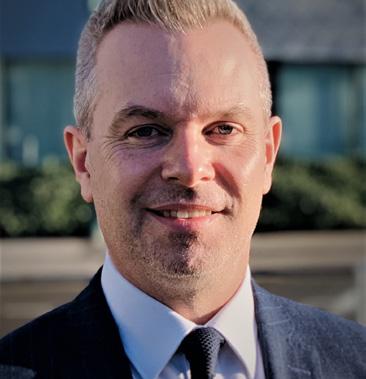
As members of the built environment community, we all have a part to play in meeting net zero targets, says Jennifer e sty, m anaging Director at Sharp Ahead.
16 TEC h NOC r AT O f C h AN g E Dave w ilkes, Director Innovation e cosystem, at Innovate UK, outlines his vision for b ritain's future economy.
Dr Séamus O’Neill, C e O of the Northern Health Science Alliance (NHSA), argues for a life sciences' super-cluster in Northern e ngland
B r Av O f O r BID w E ll S m ike Derbyshire, head of b idwells' planning practice, argues that planning reform is crucial if the UK is to become a science super-power.
NET z E r O PIONEE r S m y g reen l ab C e O James Connelly talks to Ian Halstead about his organisation's strategic vision, achievements and future direction.



3034 l AB S O f T h E f UTU r E MADE fr OM ... w OOD ? w elcome to the new frontier of laboratory design: where sustainable features include buildings with natural materials like mass timber.
37 l AB | INNO vATIONS 2022
f OCUS ON T h E f UTU r E
Jacqueline b alian, the head of g A mb ICA's laboratory, test and measurement sectors, outlines its membership strategy and operations.
39 l AB | INNO vATIONS 2022
B IO TEC h INNO vATION
Dr m agdalena Karlikowska, C e O of biotech start-up Cytecom l td., outlines the innovative research which underpins the Coventry-based enterprise.
A r E w IT h IN r EAC h f rancesca w ilkinson, sustainability manager at w illmott Dixon, explains why a knowledge-and-data based approach is the only way the science and technology industry can reach the government’s 2050 net-zero targets.
58 r&D PEOP l E AND CU lTU r E ST r ATE gy - 12 MONT h S ON e xecutive Director of Airto, Jane g ate, assesses the year since the g overnment published its strategy..
46 C y BE r r ESI l IENCE AND T h E C h A ll EN g E f O r SCIENCE PA r KS g eraint w illiams, Chief Information Security Officer at m odern Networks, discusses the multiple threats to the UK’s science parks, universities and innovation centres from cyber-attacks.
48 MEMBE r P r O f I l ES l ondon b ioScience Innovation Centre ( lb IC); Unity Campus and Oxford North.
DATA IS T h E KE y g lenn Crocker, e xecutive Director - v entures and Investment at Pioneer g roup, assesses the prospects for the UK’s life sciences’ sector



C ATA ly ST f O r CO ll ABO r ATION Operations director Sally O’Connor explains the evolution of the world’s first social science research park, Cardiff University’s SPARK.

Rajnika Hirani, Head of Sustainability at the f rancis Crick Institute, outlines her organisation's pathway to Net z ero.

Savills' commercial research director Steven l ang offers his take on growth prospects for the UK's life science sector.
Rob Sinclair, Account m anager at Siemens, outlines how UK science parks should be leading the way in sustainability.

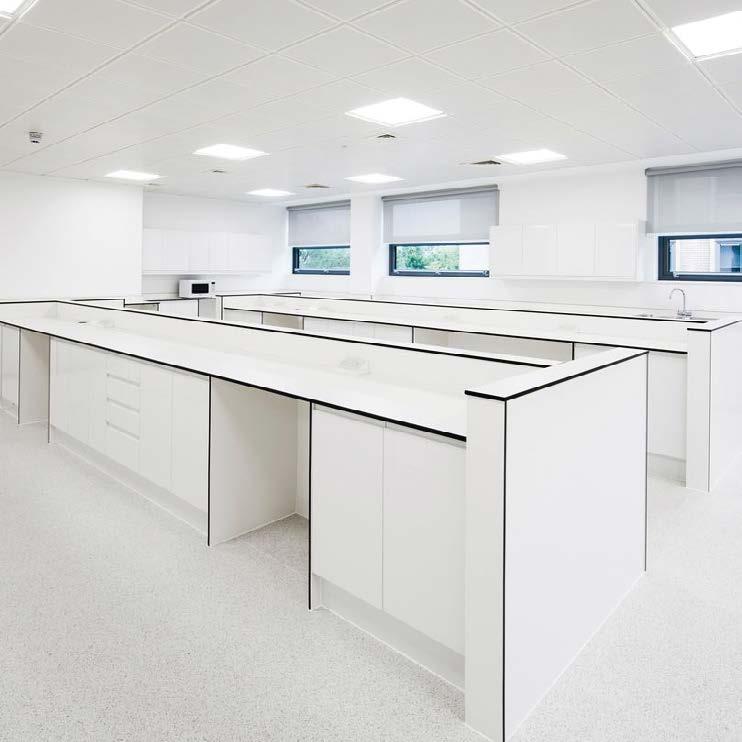

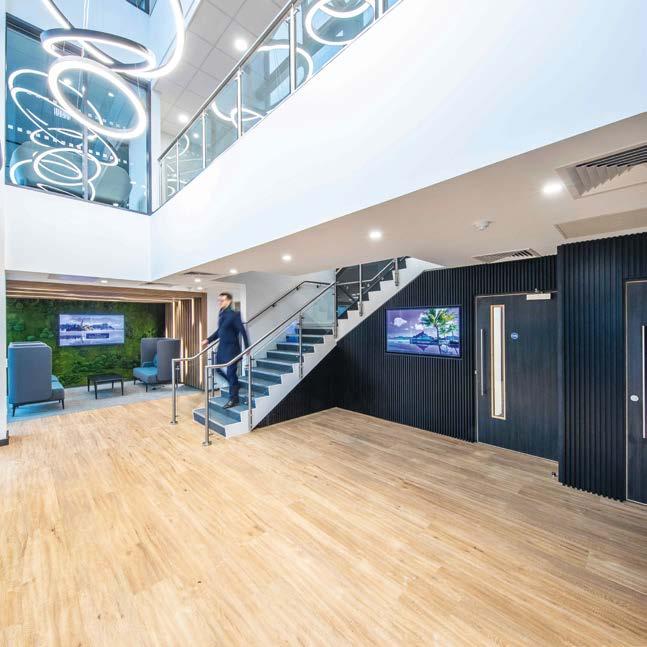

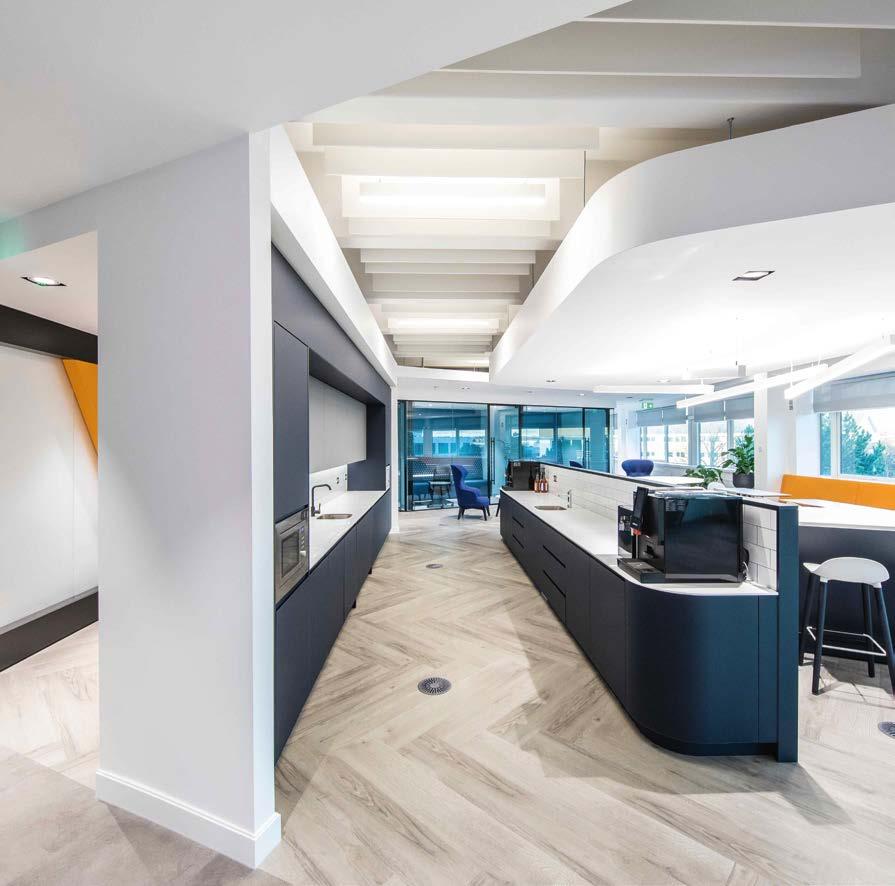
The world according to UKSPA and its members
Making thecluster case
of the Northern Health Science Alliance (NHSA), argues for a life sciences' super-cluster in


he UK has lofty ambitions when it comes to establishing itself as a world-leading life sciences superpower, but it has become increasingly clear that we cannot achieve that goal without involving the entirety of the United Kingdom.
"The vast potential of our industry base and our NHS, allied to the excellence of our universities and research eco-systems, speaks to massive opportunity in growing the health and wealth of our countries and offering boundless opportunities for patients and innovation. However, life sciences spending has until now been hugely focused in the Golden Triangle of London, Oxford and Cambridge in a selfperpetuating cycle, which means excellence elsewhere has been ignored and left unrealised, and its potential remains undeveloped.
Yet, as our report with the NP11 Local Enterprise Partnerships showed, a second UK life sciences super-cluster, complementary to that in the South-East, could in the next 20 years double employment and treble our GVA in the sector.
The new structure would be built on the strengths of the North’s £13.6bn life sciences economy, which is home to just over a fifth (21%) of the UK’s total life sciences workforce.
It would strengthen our region’s LEPs, Combined Authorities, research-intensive universities, Catapults, NHS Trusts, Academic Health Science Networks (AHSNs) and Centres, science parks and other stakeholders, enhancing the UK’s global industry offer.
As CEO of the NHSA, I have seen first-hand the excellence in research which is taking place throughout the hospitals, universities and AHSNs in our 24-member organisation which spans the North of England.

Our region has globally important areas of opportunity where its research and innovation capacity is matched by opportunity in the market, including advanced therapies; infectious diseases; diagnostics, med-tech, data and AI.
Equally, we also have challengedriven areas of opportunity, where our expertise meets growing regional, national and international need arising in health inequalities, healthy ageing, mental health and well-being.
If we don’t invest in these areas, we then miss out on building the UK as a life sciences super-power and also fail to deliver multiple benefits for the North.
Our super-cluster would build resilience in the UK’s health system, enabling it to tackle future pandemics and directly aid tackling health inequalities, which currently cost the UK more than £13 billion a year in lost productivity.
Levelling up the economy in life sciences research and innovation should be based on the mantra: “If it can be done in the North, then it should be done in the North.”
The government has put driving prosperity through research and innovation at the core of its long-term recovery strategy.
Health and life sciences are a globally recognised UK strength across all regions and nations of the UK.

No other sector provides as large a boost to the economy, and no other sector directly impacts the health of its population in the same way. Like all industries, the life sciences are seeing a revolution as technologies and challenges converge.
The future is multi-disciplinary and requires multiple partners to deliver on the potential benefits of the sector.
Our globally respected NHS, universities, science parks, LEPs and Catapults must work together under strong leadership to support the growth of innovative clusters across the UK.
If we get this right, the UK can

position itself as the high-value and high-trust centre of excellence which the global health system so badly needs.
We can do this by building a system and culture that are focused on realworld evaluations and partnerships with innovative global companies.
To do otherwise would risk the UK being outpaced by the established competitors, USA, Europe and China, or by rapidly-emerging new players across Asia, Latin America, and Africa.
Global leadership in life sciences requires every region of the UK to fulfil its potential, and for the NHS, in particular, to be a full participant.
It is also essential that new growth must be inclusive and not simply serve to entrench inequalities across the country.
The South-East makes great contributions to UK life sciences but, in combination with the strengths of the North, the collective UK health and life sciences offer to the world becomes significantly more resilient and compelling.
Responding to the opportunities offered by the sector requires an understanding of how to better link research excellence to the region’s strong and established industrial base.
We also need a commitment to provide long-term and strategic support toward this goal at both regional and local levels.
With government support, the Northern super-cluster can create 64,600 jobs and more than triple its contribution to GVA, from £5.1bn to £16.5bn.
The UK will also benefit from the increased talent pool and worldclass infrastructure that would be created to attract new companies into this region.
We also need the companies already working in the North to be anchored there and drive innovation-led growth, and all these elements will play a role in reducing health inequalities.
Unfortunately, the political rhetoric we have heard in recent years about levelling up has not yet been matched by government action.
The life sciences sector will be a litmus test for whether this new government, under its new Prime Minister, genuinely has the appetite, ideas and resolve to do what is right and fair.
Rebalancing of public sector investment to increase productivity in the North will drive increased levels of private sector investment in research and innovation, which will leverage our world-class pan-Northern assets, partnerships and collaboration.
Supporting this would be a business ecosystem, including science parks and innovation districts, to support the formation of new enterprises and the growth of existing companies and organisations.
Their impetus would encourage company investment in life sciences innovation, new developments and the evolution of a skills system which meets the needs of the whole sector.
We work in a complex ecosystem, of course, and there are lots of things to get right. However, we believe that the vision set out above is key to ensuring that a vibrant North is part of a globally competitive UK.

The UK is one sovereign country, and if we are to excel as one, it is essential that we develop the opportunities available across the entirety of the UK. To do anything else would be negligent for our health, our social cohesion, and our economic capital.” ■
For further information on the NHSA, please visit: www.thenhsa.co.uk

As members of the built environment community, we all have a part to play in meeting net zero targets, says Jennifer Esty, Managing Director at Sharp Ahead


Sustainability and decarbonisation goals are critical for meeting net zero targets. In addition to smart buildings, renewable energy sources and sustainable working practices, consider how your digital footprint is impacting your carbon consumption.
As Gerry McGovern, author of World Wide Waste, so aptly puts it: “Digital is physical. Digital is not green. Digital costs the Earth.” So, how do you reduce the carbon footprint of your digital marketing activities?
The average website produces 4.61 grams of CO2 for every page view (Source: Reset.org). For websites that have an average of 10,000 page views per month, that makes 553 kilograms of CO2 per year. For context, it would take approximately 22 trees to absorb that much carbon in a year.
There are some practical changes that will reduce this cost. And here’s the good news: the changes that reduce carbon will also improve user experience (faster page speeds, easier user journeys) and increase organic search results (because Google favours faster, better websites when ranking content).
Measure First, benchmark website performance. An easy way to do this is to use
websitecarbon.com to estimate your web page’s carbon footprint. Then use Google’s Page Speed Insights for a detailed analysis of how to improve site speed and performance.
Common causes of slow (and more carbon-hungry) pages include images that aren’t optimised, unnecessary scripts, and overly complicated designs.
Next, optimise your website following the recommendations provided by Google’s report. Additional best practices like adding a Dark Mode plugin and choosing a carbon neutral hosting provider will help reduce the overall impact of your website.
Gerry McGovern estimates that “1.6 billion trees would have to be planted to offset the pollution caused by email spam.”
Make sure you only send emails to engaged stakeholders, active cleansing email contacts and sunset persistent non-openers.
Scrutinise the design of your emails, ensuring content and imagery are optimised, necessary and producing results. Trial text only emails and consider asking subscribers how often they want to hear from you, potentially reducing the number of emails you send whilst increasing engagement.
And remember marketing emails aren’t the only ones with a carbon cost. Sending and receiving 70 emails a day creates around 84kg of CO2 (Source: CW Jobs, email calculator). Consider your own communications habits and how you and your team could reduce emails, and your carbon footprint.
If you’re using paid search, display or social, ensure those campaigns are finely tuned and closely targeted. No advertising is perfect, and some wastage is inevitable, but by following best practice you can be laser-focused on your target audiences, reduce your carbon footprint, and improve the effectiveness of your media spend. And as with improving website performance, these paid optimisations will almost certainly have the added benefit of improving KPIs such as costs per lead and costs per acquisition.
We all need to take responsibility for achieving decarbonisation goals and digital footprints are just one of the many steps we can take.
And as it turns out, decarbing your digital footprint will almost certainly improve overall marketing performance and increase ROI, helping you achieve your objectives today, and in the future. ■
For further information, please visit: www.sharpahead.com




“As we innovate more, we can also retain in the UK the intellectual property and the high value jobs which are created by the new products and services which are being delivered.”
It's the language and confident tone of a technocrat very much at ease with both his environment and the challenges ahead.
needed to commercialise them, and help the UK become a global hub for innovation by 2035.
“We are, of course, very conscious of the unprecedented pressures on public spending, but it's crucial that we focus on long-term growth through innovation.”

or centuries, British entrepreneurs bedazzled the world with their technical genius, flair for lateral thinking and talent for innovation.
Jethro Tull's seed drill triggered the agricultural revolution. John Kay and Richard Arkwright's inventions did likewise for the textile industry, and generations of engineers then created the pioneering machines and techniques which defined, and delivered, the first industrial age.
From the reflecting telescope and turbo-jet engine, to the thermos flask and tin-can, and from the pneumatic tire to the telephone, to the cat's-eye and Belisha beacon, British nous became the perennial catalyst for global change.
Wilkes, with his colleagues at Innovate UK and UK Research & Innovation (UKRI), has the challenge of continuing that long-term trend.
“The key driver for change has to be innovation because businesses who innovate will grow more, grow faster, export more and attract more investment,” he says.
“If we can inspire more UK businesses to innovate that will boost our economy, increase productivity, create more high-value jobs and make the UK even more competitive within the global economy.
After Wilkes completed undergraduate studies in the historic manufacturing centre of Sheffield, his doctoral thesis in metallurgy ushered him toward the Ministry of Defence (MoD).
He spent 20 years there, including a spell as technical director of its Research Acquisition Organisation when he led the MoD's first SME innovation programme.
A later four-year secondment in Washington DC, with the US Department of Defence, saw Wilkes work on strategy and co-ordination across $25 billion of R&D programmes, covering all four branches of the US military.
Since April 2022, he's been responsible for Innovate UK’s investments into Catapults and agri-tech centres, works closely with Innovate UK Knowledge Transfer Network and also leads the team driving increased innovation into the public sector.
“We had a spending review last year which strongly reinforced the view that greater levels of innovation would be absolutely critical to our future economy, supported by increased funding through Innovate UK,” recalls Wilkes.
“In September, we published our strategic delivery plan, describing how we will spend that money to deliver on our Plan for Action and the UKRI Strategy over the next three years.
“We will be working very closely with Catapults, Innovate UK KTN, Innovate UK EDGE and partners across UKRI and other government departments to deliver our strategy.
“We will ensure we direct our funding and support to the very best ideas that leverage the private sector investment

Wilkes says the Innovate UK Plan for Action spans five strategic themes: the future economy, growth at scale, global opportunities, the innovation ecosystem, and the presence of government 'levers'.
The latter embraces multiple ways in which business innovation can be encouraged and supported, including codes of practice, procurement, regulation, and standards.
“Many of the elements are already in place, but we do need greater and more effective connectivity. Sometimes too, it's just about making people aware of what is available and where to find the right support at the right time,” says Wilkes.
“For instance, since 2017, Innovate UK has made loans to 200 businesses to support their growth at scale through innovation.
“In August, we invited their CEOs and founders to visit our headquarters in Swindon, come together around the theme of 'storytelling', share their experiences and challenges, and then form a network to continue their engagement with each other.
“Five years ago, Innovation Loans was just a £50m pilot project, but now it's a £165m portfolio across all sectors of the economy, and it's been very satisfying to see the take-up and hear the positive feedback.
“It is also critical that our Plan for Action takes a genuinely holistic approach to challenges around innovation and economic growth.
Dave Wilkes, Director Innovation Ecosystem, at Innovate UK , outlines his vision for Britain's future economy.




“At one level, it is about ensuring that we have strong foundations, and can look to achieve the end-to-end commercialisation essential to achieve our long-term targets, but it's not just about grants, R&D projects and technology.
“The economy (and the country) needs a more diverse and inclusive workforce, and we are determined to make significant progress on these issues, which would be a fundamental shift for the UK.
“Skills is another central issue, of course, but so is how we manage and monitor the government's procurement programmes more effectively.”
EXT r AO r DINA ry IN fl UENCE Wilkes is equally passionate about his work with the Catapult centres across the UK and covering multiple sectors of the economy.
In 2010, Business Secretary Vince Cable commissioned research by the hugely successful Austrian entrepreneur,
Hermann Hauser, to indicate how Britain might once again become noted at global level for technological advances and innovation.
His report was the catalyst for the Catalyst network of centres focusing on high-growth sectors, including cell therapy, high-value manufacturing, offshore renewable energy and transport systems.
Many have won plaudits from companies in their sector, external observers, business organisations and politicians, although some suggest their level of impact hasn't been consistent.
“The Catapults are all at different stages of maturity and address the different needs of industry across different sectors, but all are making a significant contribution to innovation, to industry and the economy.
“Equally, because the portfolio is so diverse, other Catapults operate on a very different scale. The Energy Systems Catapult in Birmingham is very different from the enormous facilities of the Offshore Renewable Energy Catapult in Blyth, but they're all doing fantastic work.
“You may not be aware that the Cell and Gene Therapy Catapult operated from the 12th floor of Guy’s Hospital in London, but since it opened in 2014, it has supported development of the second largest cluster in its niche outside the US.

“Catapults have extraordinary influence in their sector, and the scale and importance of the innovative products or services which they are delivering will help to ensure innovation is at the heart of the UK economy.”
It's a confident message, and one which staff at the Catapults will be delighted to hear.
Given the multiple facets of his role, it's no surprise to discover that Wilkes spends much of his time visiting facilities and innovators round the country from Innovate UK’s Wiltshire base.
Whilst it's never necessary to 'break the ice' upon meeting this genial individual, for those who might wonder, the topic of his doctoral research was 'The rapid solidification of aluminium alloys'.
Probably best just to offer a hand, and ask: “It's Dave isn't it …?” ■
More detail about UKRI's commitment to research and innovation, and the strategic delivery plans of the individual councils which make up the organisation, can be discovered at: www. ukri.org/news/ukri-unveils-detailedplans-for-research-and-innovation/
“C ATAPU l TS HA ve ex TRAORDINAR y IN fl U e NC e IN TH e IR S e CTOR , AND TH e SCA le AND I m PORTANC e O f TH e INNO v ATI ve PRODUCTS OR S e R v IC e S w HICH TH ey AR e D el I ve RIN g w I ll H el P TO e NSUR e INNO v ATION IS AT TH e H e ART O f TH e UK e CONO my.”The high-value Manufacturing Catapult recently moved its hQ to the Innovation Birmingham campus
























The first university-based research park was created more than 70 years ago, when an academic institution heavy in assets, but light on finance, decided that developing land for R&D uses could transform its fortunes.
Stanford Research Park immediately succeeded in attracting numerous technology pioneers, later became the catalyst for Silicon Valley and the companies currently based on its sprawling 700-acre campus include Tesla Motors, Hewlett-Packard and VMware Inc.
Inevitably, the fledgling location in Cardiff is on a more modest scale, though it’s still a very sizeable scheme by UK standards. SPARK itself is a £60m project, nestling within the university’s £300m Innovation Campus.
The new hub is both imposing and eye-catching, with 12,000 sq ft of space spread across seven floors, including 2,800 sq ft of commercial units.
Its most spectacular feature is a sculptural staircase dubbed the ‘Oculus’, which rises through the full height of the building and was designed to encourage social interaction between tenants.
“Collaboration is a core element of SPARK, so we have breakout zones at each level to encourage people who would simply pass each other by in a traditional building to talk and discuss their projects,” says O’Connor.
“We were determined to eradicate the old ‘pigeonhole’ approach within social sciences, so this building was designed to stimulate conversations and integration, and we worked closely with colleagues from other areas of the university to develop the model.
On and off-site services for your business Operations director Sally O’Connor explains the evolution of the world’s first social science research park, Cardiff University’s SPARK .

“For instance, a team from Cardiff Business School (CBS) looked at ways in which organisations would be motivated to come to the collaborative environment we were looking to create, and what employers would find attractive if they were considering locating their enterprises here.”
SPARK will ultimately house around 800 people, split evenly between academics, researchers, students and other staff, and external organisations from the public, private and the third sectors.
At its heart are some of the university’s leading social science research centres, with world-leading expertise in policy innovation, education, public health improvement, civil society, economic analysis, crime and security, public service innovation, social care and public policy.
Alongside these research centres are tenants and members from the public, private and third sector – all co-located to help identify solutions to complex societal challenges.
SPARK also provides a hub to help advance areas of research expertise in cyber security, fin-tech, med-tech, data science, digital transformation and behavioural science.
It’s very much a concept conceived, developed and delivered in Wales, but there are tangible parallels between the strategic approach taken by Stanford all those decades ago and the philosophy which underpins the innovative development of SPARK.
Stanford’s pioneers decided that for their venture to succeed it had to generate significant social and economic benefits for its local community in Palo Alto.
Also, despite the university’s pressing need for finance, its management team screened every potential tenant rigorously to ensure
that their values dovetailed with the university’s strategic objectives.
It wasn’t a property play with the desire to fill space as quickly as possible, and that approach has been crucial to its success and longevity.
As O’Connor vividly details the long pathway which led to the opening of SPARK on St David’s Day in 2022, it’s clear that the same mindset has been present from the start at Cardiff University.

“Long before construction began, we all spent a great deal time thinking about the ways in which creative collaboration could happen here, and the best physical environment in which to help it happen,” she says.

“We wanted to ensure we had the right people in the right spaces, and because SPARK has been designed to create public-private partnerships, the co-location of tenants was also key.
“Every external organisation or body wishing to come here has to explain how they plan to work, and what benefits they will bring.
“Throughout the labs and co-working space, there’s a strong emphasis on tenants and members who want to work with the university. Students, graduates, researchers and our academics are all here, so it’s a very fertile location for interaction and we hope, innovation.
“We have learned the lessons from other schemes which didn’t deliver the benefits they expected for their local communities, so facilitating such interactions was an early element of our strategy.
“It’s never been about filling space with any tenants willing to pay rent. The community we are building here will have a shared vision, to deliver benefits for the university, the city, the public and the Welsh economy. This is not a ‘build it and they will come’ approach.”
“ T H e CO mm UNIT y we AR e b UI l DIN g H e R e w I ll HA ve A SHAR e D v ISION , TO D el I ve R be N ef ITS f OR TH e UNI ve RSIT y, TH e CIT y, TH e PU bl IC AND TH e w el SH e CONO my. T HIS IS NOT A 'b UI l D IT AND TH ey w I ll CO me' APPROACH ” SAlly O ' CONNOR , OP e RATIONS DIR e CTOR , SPARK
Just as Stanford was driven by a desire to bring jobs and wealth to Palo Alto, which in the early 1950s was just another small town with no identity or particular purpose, the SPARK team are focused squarely on the needs of Cardiff and South Wales.
“We have to focus on the socialeconomic challenges in the city and also in the valleys. We have some of the UK’s most deprived areas in this region, with deep-rooted problems which haven’t been effectively addressed,” says O’Connor.
However, for all the parallels with the Stanford vision, the catalyst for SPARK was very much of the digital era.
“The idea came from a blog by Adam Price, who is now the leader of Plaid Cymru, but at the time worked for the London-based innovation agency, Nesta,” recalls O’Connor.
He was a senior programme manager working on innovations within public services, and he co-authored a pioneering report on the challenges which Wales faced, and how innovation might be driven into its economy.
Price’s keynote idea was that specialist space could be built to co-locate social scientists with researchers from other sectors, external researchers and collaborators from the private, public and third sectors.
His theory was that such interactions would deliver new insights into public policy and the provision of services, creating the foundations for economic, public and social innovation.
“Adam wrote a blog on the subject, which was picked up by academics at CBS who engaged with him on Twitter,” says O’Connor.
“The Vice-Chancellor at the time became involved and realised that Cardiff had under-invested in new research space by comparison with other major universities, but also acknowledged that

Cardiff was nationally-leading in its social science research.
“We then went on visits to research-led academic institutions, including Harvard and MIT, to learn how they’d evolved.

“It was very valuable because we brought back a great deal of knowledge to inform our internal discussions about the form we wanted SPARK to take. Adam worked with us and helped develop the concept.”
As the vision grew to match the scale of expectations so did the projected budget, but the funding model was equally innovative.
Instead of relying on grants from local or national government, the university assembled most of the required £60m from long-term bonds.
The approach to matters of finance at the personal level much further along in the project’s evolution was also original, as O’Connor explains.
“Given our commitment to drive growth into the regional economy, it seemed only right that everyone who worked at SPARK, whether directly through the university, for tenants, members or with on-site contractors, should receive at least the real Living Wage.
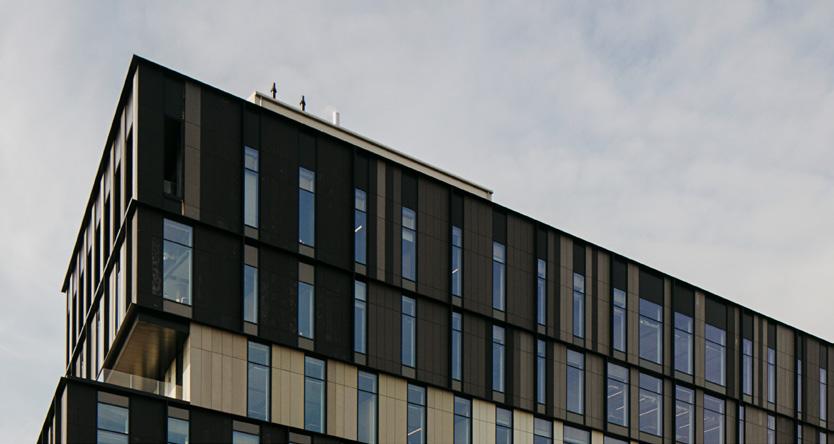
“Cardiff announced in 2019 that its ambition was to ensure every worker was paid at least that amount.
"We decided to support them, and worked with Cynnal Cymru, the sustainable development forum for Wales - to receive accreditation from the Living Wage Foundation.
“We were very proud to become the world’s first research park dedicated to the social sciences and are equally so to be the first Living Wage Building in Wales.”
Asking O’Connor to identify a tenant which especially enthuses her is like asking a youngster which Christmas Day gift they preferred, but she does highlight the presence of RemakerSpace, which is headed by Professor Aris Syntetos.
“It was developed by the university’s PARC Institute to deliver workshops, training and mentoring which will help the community and local businesses discover the benefits of the circular economy,” she says.
“The Welsh government gave us £600,000 to fund the project, and I’m sure the logic of re-manufacturing and repairing products will be immediately appealing, particularly given the cost-of-living challenges which are currently impacting so many people.”
It is, of course, impossibly early in SPARK’s evolution to even guess at its future impact within the South Wales economy.
However, given the parallels between Stanford and Cardiff, it felt so right that when SPARK announced that its first tenant would be Bipsync.
The US fin-tech enterprise, which designs research management software, is now headquartered in New York, but was founded at the US university back in 2013.
Perhaps even the founding force behind Silicon Valley can learn something from O’Connor and her colleagues at SPARK. ■
To discover more about the operations of this innovative social science research park, please visit: www.cardiff.ac.uk/ social-science-research-park/about-us




If you are relocating your laboratory, need project management support or just looking for storage of equipment and consumables, Harrow Green Laboratory
Services are the experts you can trust. We have branches in every major UK city and we are able to undertake any size and type of relocations at any location including all UK Science Parks, Universities and public sector institutions.
We look after:
Full turnkey relocation project management, OEM and third party vendor management, Chemical relocations and disposal,










Cold chain relocation (including LN2), Equipment packing, relocation and unpacking,

Crate and packing material supply, Clean room relocations,
Large and heavy equipment relocation, Office, breakout space and write up area relocation, IT relocation, including decommissioning and recommissioning.
“We used
move
to a
are a rapidly expanding BioTech
based in Oxford and required RHG to move three labs and two offices to a larger space. We had a lot of sensitive equipment and temperature sensitive samples and these were all handled with care. The team was friendly and checked in with us on everything they were doing. They were also very flexible. We had to change the date of our move and RHG accommodated us without any problem. “
 @HarrowGreen
@HarrowGreen
Nay-sayers sometimes suggest that the public and the private sectors are like oil and water. They can be persuaded to flow in the same direction … but will never truly mix.
However, after just a few moments in the company of the effervescent Rajnika Hirani, it's evident that their view is a myth.
Impressively, she chose her career path very deliberately to embrace both sectors, and acquire the multiple experiences and knowledge required for her current role.
“I began my career at Defra, looking at how European directives on waste management could be transposed into national legislation, learning about everything from environmental planning and pollution control to corporate responsibility strategies and stakeholder engagement,” recalls Hirani.
She then deepened her understanding of how the physical environment impacted the environment by working as a project manager for the Construction Industry Research and Information Association, an independent not-for-profit organisation.
Whilst there, Hirani learned how to develop and disseminate good practice guidance about the decommissioning of nuclear and defence sites, which prepared her for pretty much any future challenge and included every aspect of a sustainable strategy from procurement to CSR.

“I then decided to widen my skill-set by moving to the private sector, to fully understand what it would be like to work from a different perspective,” she says.
Her first role wasn't a huge move in the geographic sense, as an EMS manager with Southern Railway, but her second most certainly was … in Laos and Bolivia.
Spending a year in those countries as a volunteer, working on development projects as varied as agriculture, tourism, and environmental awareness, gave Hirani a very practical insight into the challenges of sustainability on the front-line.
Back in London, she took on two more equally varied management roles, first trying to reduce the impact of the UK's Parliamentary estate on the environment whilst being mindful of the needs of a UNESCO heritage site, before spending three years at the UCL Hospitals NHS Foundation Trust.
Hirani then joined the Crick in late-2017 and is now responsible for leading all elements of its sustainability strategy.
From embedding a Net Zero mindset throughout its structures, to implementing the myriad of processes and systems required to deliver a safe and sustainable research environment, it's a challenge of significant scope and scale.
“We take a holistic view of sustainability, so whilst we're naturally looking to reduce emissions and waste in every aspect of our operations, from our procurement policies to

Rajnika Hirani, Head of Sustainability at the Francis Crick Institute, outlines her organisation's pathway to Net Zero.rajnika hirani
our water consumption, we also focus on the well-being of everyone here and those within our wider community,” she says.
“Our core goal is trying to decarbonise the Crick. We just upgraded our stairwell lighting for instance, which previously had been on 24/7 because they were emergency routes.
“When we looked at other aspects of our energy use, we realised we could save more than 100 tonnes of carbon a year simply by optimising the temperature in our Data Centre CRAC Units.
“We are also very keen on proactive analytics, which is essentially using algorithms to analyse the data from our building management systems (BMS) and identify areas where efficiency improvements could be made.

“This package works in real-time and monitors our BMS so we can easily see where systems are not operating at the optimal level, and then make them more efficient and plan maintenance works in advance. Based on our total energy consumption, we estimate this system could save us more than £250,000 per year.”
As the institute houses some 1,200 scientists, researchers, technicians and analysts, Hirani has a mammoth task ahead to deliver on its Net Zero ambitions, but she does have a small army of enthusiastic assistants.
“For the last three years we have had a structure with around 80 individuals called 'sustainability reps’ who come to
my workshops. I develop their skills, and they then cascade their thoughts to others,” she says.
“They're all volunteers, come from all areas of the Crick, and they are my eyes and ears. I don't have a background in science, but they have the specialist knowledge about how labs work, in life sciences and in other areas.
“They're all very conscientious, eager to help and very passionate which is a great quality. In general, the younger scientists are more concerned about the environment from the widest possible perspective and our impact upon it, but they are all extremely committed.
“These reps can influence their peers, discuss our strategy and targets and feedback their opinions to me, so it is
very much a two-way process. There is absolutely no pressure on them to volunteer, and it's a very stimulating and productive form of workplace engagement.”
Hirani, who modestly refers to herself as a 'matrix manager', is also working with an array of external partners, stakeholders, and suppliers.
“Now the board has formally made a commitment to Net Zero, it's about making sure everyone understands our targets and sees the pathways by which we can achieve our shared goals,” she says.
“At the moment, we're looking at every element within our procurement programme from purchasing to cleaning and catering.
“We already have clauses within our supplier contracts detailing what we expect from them and discovering how they intend to make the journey to Net Zero or Carbon Net Zero.
“As we move forward, we might add additional clauses into the contracts to make sure our requirements are explicit, particularly on health and safety and carbon emissions.
“I am a great believer in encouraging SMEs to evolve their own pathways, and if they're not already there now, they can join us on our journey. It's not about implementing a top-down approach. Like my relationship with our sustainability reps, it's a two-way process.”
Another core pathway is the Crick's change programme (Green Impact, NUS) which is now into its third year.
“You could say this is a grass-roots approach because it's all about engaging with people, trying to change how they work in their labs, but also how they use their office space,” says Hirani.
Her experience working within the Parliamentary estate made her aware that all elements of an organisation's real estate portfolio must be included, if a Net Zero Carbon programme is to be successfully implemented.
“Some people suggest our government could do more about sustainability, but I think they'd be surprised, how much they are doing,
certainly if their efforts were compared to those of many other governments,” says Hirani.
However, although engagement with internal staff and external suppliers and stakeholders is crucial, she admits that – whether it's the Crick, a science park or any organisation seeking to achieve its sustainability goals – active support from the boardroom is always vital.

“It's not about the size of your senior management team, or the number of executives who are involved, but it is about their commitment, as individuals and collectively,” she says.
“I know from my experiences elsewhere that no sustainability strategy can succeed unless everyone within the organisation buys into the process, and proactive leadership is critical.
“Fortunately, we have commitment right from the top of our pyramid to the bottom, which does make the challenges easier to overcome.”
Hirani's personal commitment is evident, and her dedication to the sustainability cause is underlined as she recounts a family holiday to Barcelona in 2022. Tourists flock there in their millions each year, of course, attracted by the magnificent cathedrals and basilica, the flamenco dances, and other cultural elements … perhaps even the Camp Nou.
However, Hirani's standout moment was to see the features which the legendary Catalan modernist architect, Antoni Gaudi, incorporated into his work.
“It was stunning to look at the innovations he'd used for lighting and temperature control more than a century ago, and to realise he'd been thinking about sustainability then, and yet the developed world has only recently decided what needs to be done.” ■
To discover more about the remarkable research carried out at the Crick, please visit: www.crick.ac.uk/
“ w e TAK e A HO l ISTIC v I ew O f SUSTAINA b I l IT y, SO w HI l ST we' R e NATURA lly l OOKIN g TO R e DUC e em ISSIONS AND w AST e IN eve R y ASP e CT O f OUR OP e RATIONS , we A l SO f OCUS ON TH e well-be IN g O f eve R y ON e H e R e AND THOS e w ITHIN OUR w ID e R CO mm UNIT y. ”
RAJNIKA HIRANI , f RANCIS CRICK INSTITUT ec redit:






assion was the catalyst for the creation of My Green Lab almost a decade ago, and it's still the driving force for this fast-growing international non-profit which pioneered the concept of laboratory sustainability.
In August, the San Diego-headquartered organisation revealed with understandable pride that its flagship programme had now been adopted by more than 1,000 labs around the world and had engaged with more than 10,000 scientists.
My Green Lab Certification was recognised in the fall of 2021 as a key measure of progress toward a sustainable future for the lab community, by the UN Climate Change 'Race to Zero' campaign.


Given its remarkable growth trajectory since 2013, it's instructive to look back at the personal evolution of both its founder Allison Paradise and James Connelly, who has taken up her CEO's baton to great effect.
The former acquired degrees in neuroscience from the universities of Brown and Harvard to underpin a passion for research which evolved during her teenage years.
Whilst specialising in such niches as muscular dystrophy, spinal cord regeneration, and neural circuitry, Paradise came to recognise that scientists couldn't create a culture of sustainability within their community without considering and questioning their own professional habits.
Her breakthrough was to realise that such individuals needed to identify the scientific routines and protocols which they were following and assess their own environmental impact.
Laboratories are very intensive consumers of energy, so she founded My Green Lab to work with scientists, researchers, pharma companies, and manufacturing supply chains
My Green Lab CEO James Connelly talks to Ian Halstead about his organisation's strategic vision, achievements and future direction.
Meanwhile, just as Paradise's fledgling thoughts about creating an organisation to deliver her transformational vision began to take form during 2012, Connelly was on his own pathway to the sustainability cause whilst on a Fulbright Scholarship in China.
An architect by profession, he developed a particular passion for green building designs during his studies at university in Beijing.
“The pollution there was so bad that sometimes you could barely see across the street,” recalls Connelly. “Ironically, the building in which were working were causing this pollution.
“It made me realise that architects were a major contributor to the problem, and since then I've dedicated my professional life to being part of the solution.”
Connelly subsequently returned to the US and joined the Seattle-based International Living Future Institute (ILFI), an organisation dedicated to building green space around the world.
His professional expertise in architecture and commitment to the sustainability cause was a potent combination, and he swiftly rose to lead the institute’s international growth strategy and become a founder and board member of its European arm.
“It’s hard to believe now that the idea of Net Zero buildings was once considered quite a crazy idea. Zero Energy is becoming standard practice and the whole industry has evolved drastically over a relatively short time,” says Connelly.
Both he and Paradise had swiftly seen the merit of benchmarking as the crucial strategic driver to create a culture of sustainability in their respective sectors.
She established the first-ever sustainability criteria for lab operations and products, set up the My Green Lab Certification programme, and collaborated with the Department of Energy and ENERGY STAR to develop new standards for lab equipment.
Paradise also developed the world’s first environmental impact factor program for lab products, ACT, now the leading ecolabel for lab consumables, chemicals, reagents, and equipment.

Meanwhile, at ILFI, Connelly had created an innovative ingredient transparency label for non-toxic building products (Declare), the world's most advanced sustainability standard for building products (Living Product Challenge), and the Zero Carbon Building Certification program.
He also established the Just concept, through which ILFI looked to increase corporate transparency by inviting organisations to evaluate themselves through the lens of social justice and equity.
Given that both were based on the West Coast and shared a passion for reducing global energy use and emissions, it was inevitable that they'd meet … and when they did, Paradise persuaded Connelly to join My Green Lab's board to develop its growth strategy.
“I shared Allison's vision that science should lead the world when we are looking to make the journey to Net Zero, and she encouraged me to look at the challenges from the perspective of laboratories, because they are such intensive consumers of energy,” he recalls.
“We both believe that society must put sustainability at the heart of the process when we are making long-term strategic decisions and investments which will impact the environment, the planet, and society as a whole.
“However, after seven years at My Green Lab, Allison decided to step aside and pursue her passion for change from a different perspective by founding The Epicentre, which empowers children and young adults to understand themselves, their purpose, and their potential.
“We really had grown at an incredible rate in little more than three years. We were now working with more than 1,000 labs at leading companies, and research centres around the world, including John Hopkins and the University of California.”
TO D el I ve R A l A b w HICH IS b R ee A m e x C elle NT , OR HAS lee D C e RTI f ICATION ,
b UT TH ey N ee D TO b ROAD e N TH e IR m INDS e T
TO THINK A b OUT TH e OCCUPANTS O f THAT SPAC e, HO w IT w I ll be US e D , AND w HAT POT e NTIA l TH ey m A y be m ISSIN g TO R e DUC e TH e US e O f l I g HTIN g AND H e AT . ” J A me S CONNe lly, C e O , my g R ee N l A b
It's been a challenging time driving forward an international and ambitious organisation, but it's abundantly clear that Connelly has lost absolutely none of his enthusiasm for the cause.
“Right from the start, we've had conversations (always passionate and sometimes quite forceful) to make people realise that science isn't purely about delivering amazing innovations and life-saving treatments, we always need to think about what is happening in our labs.”
“ T OO m AN y D e SI g N e RS AR e STI ll TR y IN gMy green lab impact map in 2022
“However, there is still something of a disconnect between some members of the real estate profession and the science community.
“Labs operate hugely energyconsuming equipment in buildings which contain large amounts of energy and carbon, and that can't be separated from the science.
“As with all issues around sustainability and the pathway to Net Zero, it's about behaviour and outcomes. You can design a green lab, but if you don't then operate it efficiently, you are missing the point.
“Too many designers are still trying to deliver a lab which is BREEAM Excellent, or has LEED certification, but they need to broaden their mindset to think about the occupants of that space, how it will be used, and what potential they may be missing to reduce the use of lighting and heat.
“There's often still also a disconnect within the lab environment. We want to empower the scientists, researchers, and technicians who work in these labs to understand how they operate as consumers of light, heat, and energy rather than only focusing on the underlying science.
“Much of our work is about making people realise that relatively simple and short-term changes in operational procedures and behaviour can deliver long-term benefits,” he says.
As the numbers indicate, My Green Lab Certification has become a key driver of change, not least because it requires
that those achieving the standard must re-certify within two years.
Connelly says most organisations return for their follow-up assessment well ahead of that deadline and sees an important secondary benefit.
“We require a majority of scientists and others involved in their processes within each lab to engage with our programme.
“As a result, we see not only better outcomes, but – and this applies to small bio-science start-ups right to the very large bio-pharma corporates – people learn more about their working environment and how their business operates by being involved in this programme.
“Rather than staying just in their niches, they develop a wider understanding of the business and their role within it. It really is a true engagement process which is why it's become popular.”
My Green Lab launched an online Ambassador programme in May 2020, allowing scientists and lab staff keen to learn more about sustainability within their environment to engage with an array of training videos, assessment quizzes, and discussion groups for free.
Participants can then network within the Ambassador community, use a dedicated Microsoft Teams' channel, take part in themed virtual discussions, and cascade ideas to their colleagues.
“The programme was designed to be informative and detailed, but also to be enjoyable. We now have 2,000
ambassadors in 45 countries, and their influence has become a very powerful tool,” says Connelly.
Equally, he well realises that My Green Lab must constantly assess itself to ensure that its programmes and processes are having tangible and demonstrable impact.
“We are constantly benchmarking ourselves to ensure that even as our global outreach continues to grow, we are more rigorous and focus even more intently on carbon reduction,” says Connelly.
“We want to go further and faster and finding the right partners to help us achieve our goals will be crucial. At the same time, we must ensure that none of our work is 'greenwashed,' which we do see in some companies and in some sectors.
“You must always measure achievements versus a benchmark to ensure you're achieving your goals, and from an external perspective to see what scale of an impact you're having on the market.
“Also, and this applies as much to politicians and policy-makers as to scientists, you can't make public statements which aren't backed by solid and credible data, so we always provide proven processes supported by thirdparty analysis.”
My Green Lab has been a non-profit since it was founded in 2013, but Connelly and his board members are currently evaluating their options to see if change could be delivered at greater scale through a different structure.
“We're thinking about how we move forward as an organisation, how we maintain our standards, how we ensure that all programmes are focused on driving change, and how we monitor their impact,” he says.
“We are likely to have a greater focus on strategic partnerships to achieve the change that is required, given the scale of the climate emergency facing us.
“Equally though, we also want to remain flexible, and to ensure that our strategic goals are dovetailed with the goals of the businesses and organisations with whom we work.” ■
Much more can be found about this pioneering organisation and its commitment to scientific sustainability at: www.mygreenlab.org
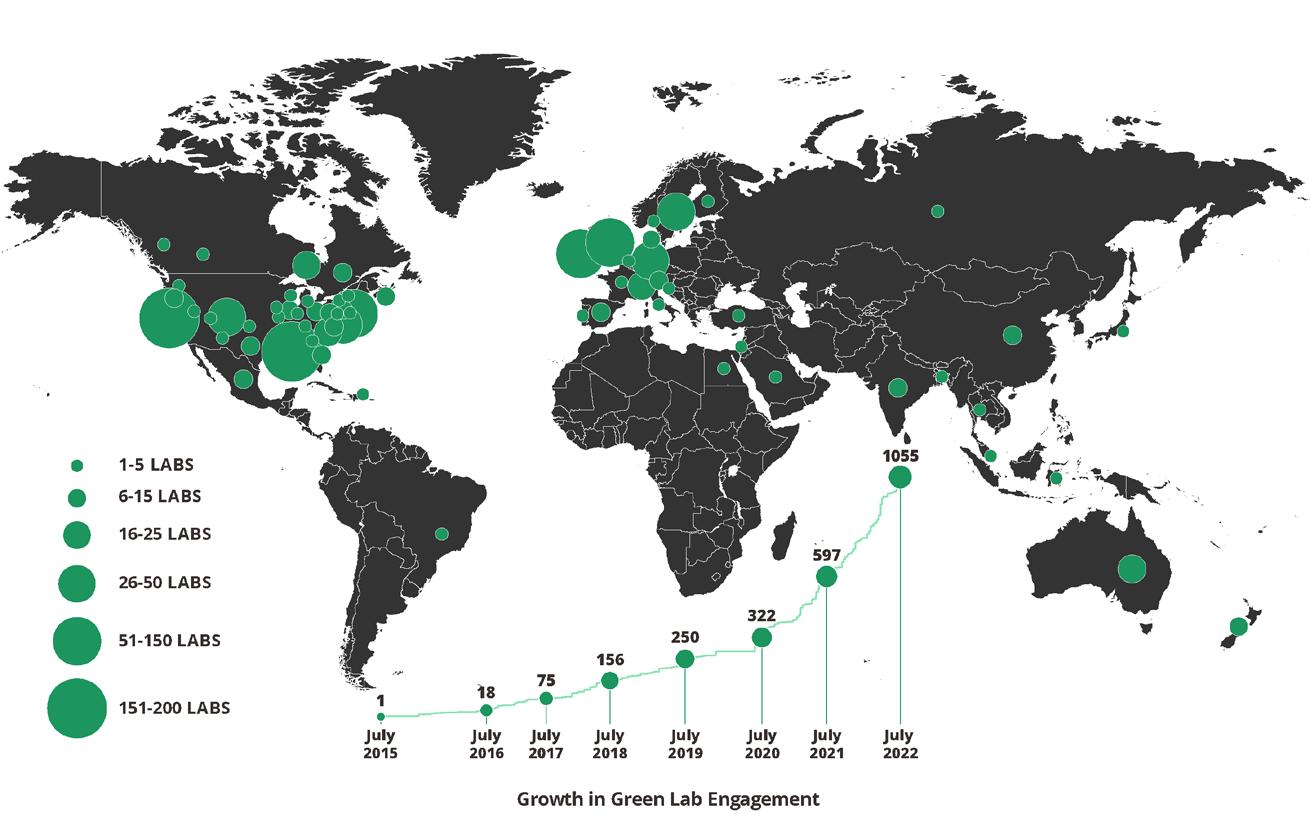
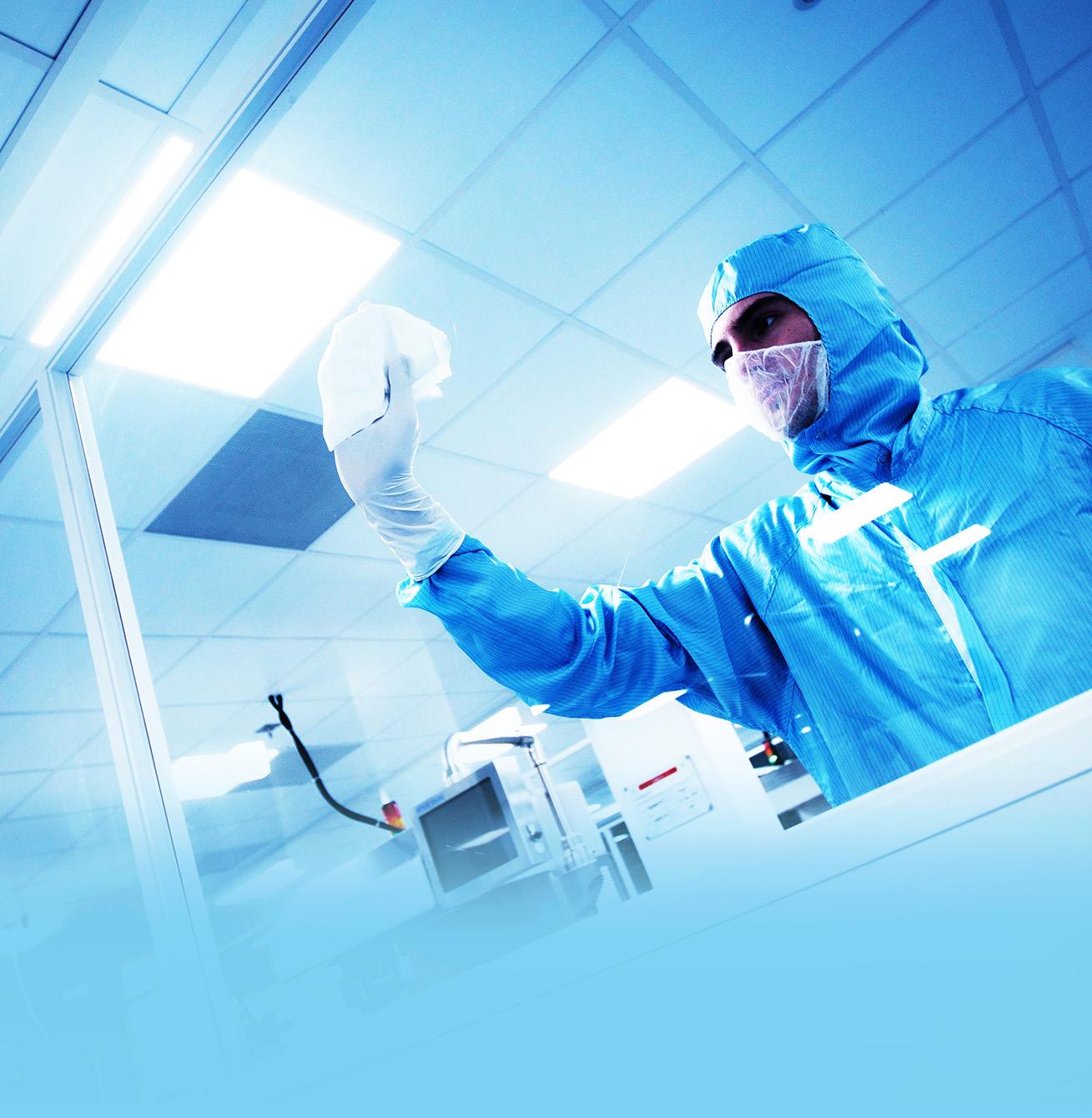


elcome to the new frontier of laboratory design: where sustainable features include buildings with natural materials like mass timber. Lab builders in the United States are looking for new ways to reduce their environmental impacts – while creating beautiful, inspiring workplaces.

Energy efficient building systems are already common features of new labs. All electric heating and on-site renewable energy are also increasingly common. Now, builders are looking to reduce their carbon footprint by turning toward new, low carbon construction techniques. Mass Timber is not only an aesthetically pleasing building material, but it also passes fire safety codes, structural engineering hurdles and sequesters carbon dioxide that would otherwise end up warming our planet.

Building construction uses tremendous resources, through material extraction, manufacturing, transportation, and assembly.
“Embodied Carbon” refers to all the emissions created by these activities.

If we think about our purchasing decisions by how they impact our environment, it can open our eyes to smarter solutions. For buildings, there are many decisions to make: from structural system, to cladding material, to flooring type, to paint. Our research indicates that all these decisions have an impact on Embodied Carbon1







Choosing materials that require less energy to extract from the earth, that take less energy to manufacture, and are lighter to transport can reduce emissions at every stage of the construction supply chain, result in significant carbon savings.
 western washington University
c redit: p erkins&Will
western washington University
c redit: p erkins&Will
Additionally, using bio-based materials that sequester carbon from the atmosphere can reduce emissions; some examples include wood, bamboo, and cork. These materials must be sourced from sustainably managed forests, to ensure that they are effectively sequestering carbon.
Advanced new products made from bio-based materials are now available. Mass Timber, an engineered structural material made by gluing together small wood pieces, is a promising new technology. In addition to offering a novel sustainable solution, Mass Timber has superior structural characteristics, excellent fire resistance, and a beautiful appearance. Builders are increasingly using this technology for new laboratory buildings.
The latest edition of the International Building Code (IBC) now includes rules specific to Mass Timber buildings which has been a game changer for use of this technology. Mass Timber not only shows fire resistance, but it is fully compatible with chemical control areas specific to lab buildings.
Through extensive research and testing2, various Mass Timber assemblies, with and without noncombustible protection, have been shown to provide substantial fire resistance. When a structural wood element such as a beam
or column burns, the surface exposed to the fire creates a char layer, protecting the element from heat. Structural engineers ‘oversize’ beams and columns to account for the char thickness, allowing them to be designed as fully exposed. This exposed wood aesthetic changes the building occupants’ experience in a laboratory setting, transforming it from sterile and monocrhome to warm and inviting.
Builders pursuing Mass Timber buildings should consult a code expert knowledgeable in both laboratory hazards and Mass Timber, to ensure the nuances of these new rules are incorporated into the building design.


Mass Timber is an alternative to conventional steel and concrete building structure. Concrete and steel systems both provide high mass and stiffness, which are advantageous for longer spans and stiffer floors. Mass Timber has similar structural characteristics, but with much less embodied carbon.
Structural design of laboratories is governed by the capacity of the framing to mitigate floor vibrations, supporting the use of laboratory equipment. Through various studies, we have found promising results using Mass Timber framing to achieve laboratory grade vibration performance, particularly where composite action between the deck timber and the supporting beam element timber is considered. Framing depths are somewhat greater than conventional systems, but creative framing layouts still allow for functional layout of MEP and lighting systems.
In contrast to steel or concrete framing, wood framing sequesters a significant amount of carbon. A new system does require new thinking.
From an embodied carbon standpoint, the larger the Mass Timber structural framing members used, the greater the carbon storage potential.
For many years, sustainable design for laboratory buildings has been focused on reducing operational carbon, primarily by improving energy efficiency.
Lab buildings are some of the most energy intensive buildings (a typical biology lab might use 1700 kWh/m2/yr3). Operational recommendations span everywhere from airside heat recovery, product solutions like low-flow fume hoods, to things as simple as building orientation and taking advantage of natural daylighting to minimize electricity use where possible. But the embodied carbon of a lab building’s material makeup offers even more carbon reduction potential.
Our research shows that embodied carbon emissions, while not equal to that of operational reductions, still carry a significant weight for the total carbon impact of a project. Designing with Mass Timber is just one of many ways that the embodied carbon impact of labs can be reduced. Instead of building all labs new from virgin materials, the path to embodied carbon reduction involves both repurposing existing structures and introducing less toxic, natural materials where appropriate. The more we research and explore these strategies, the more viable they are as design solutions.
Lab builders should consider measures to reduce both operational and embodied carbon when looking to reduce a project’s overall carbon footprint. The time is now; we have the tools and the data to change the way we build labs, for a better future. ■
1 https://research.perkinswill.com/ wp-content/uploads/2021/12/LowCarbon-Labs_COMBINED-.pdf
2 www.nfpa.org/News-and-Research/ Data-research-and-tools/Building-andLife-Safety/Fire-Safety-Challenges-ofTall-Wood-Buildings-Phase-2
3 https://www.worldgbc.org/news-media/ global-status-report-2017
For further information on Perkins&Will, please visit: https://perkinswill.com
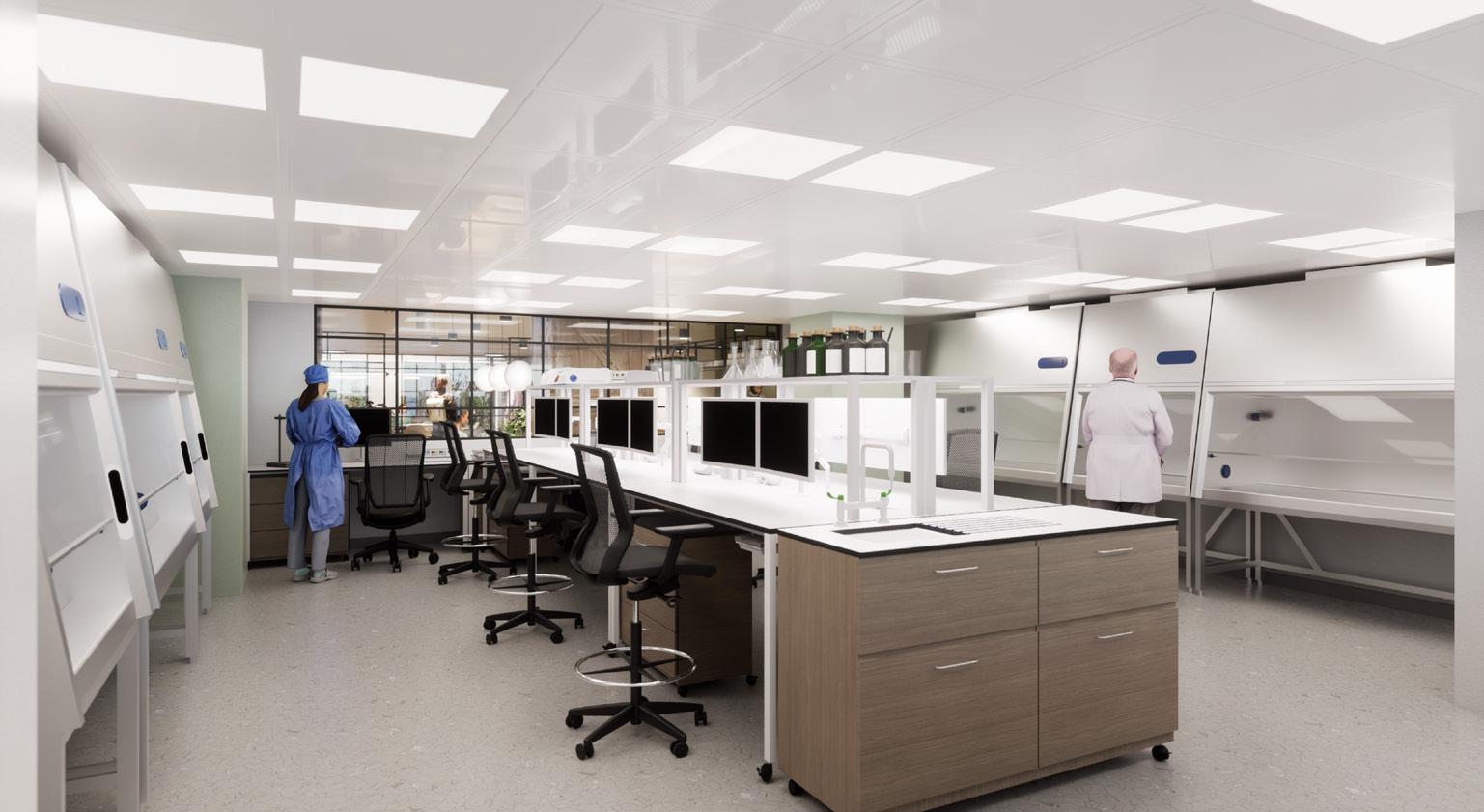

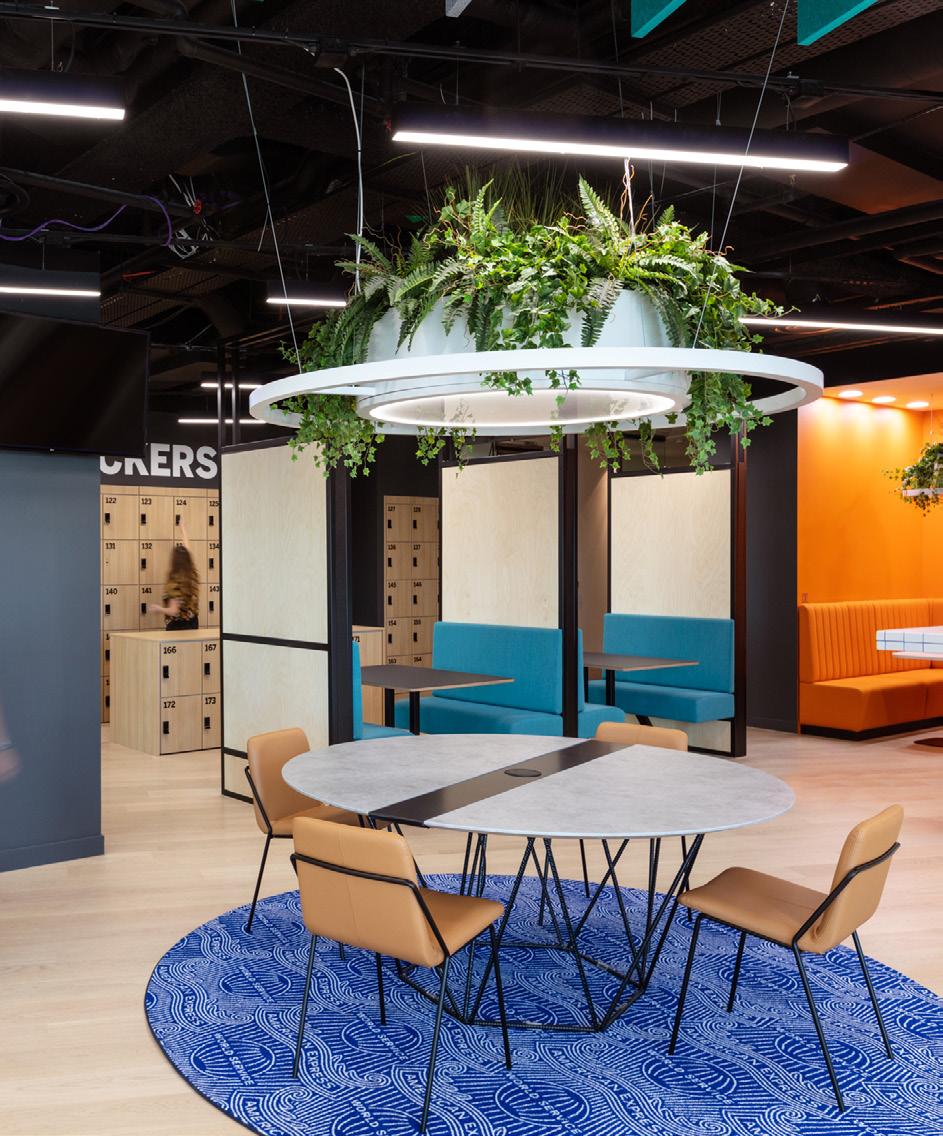
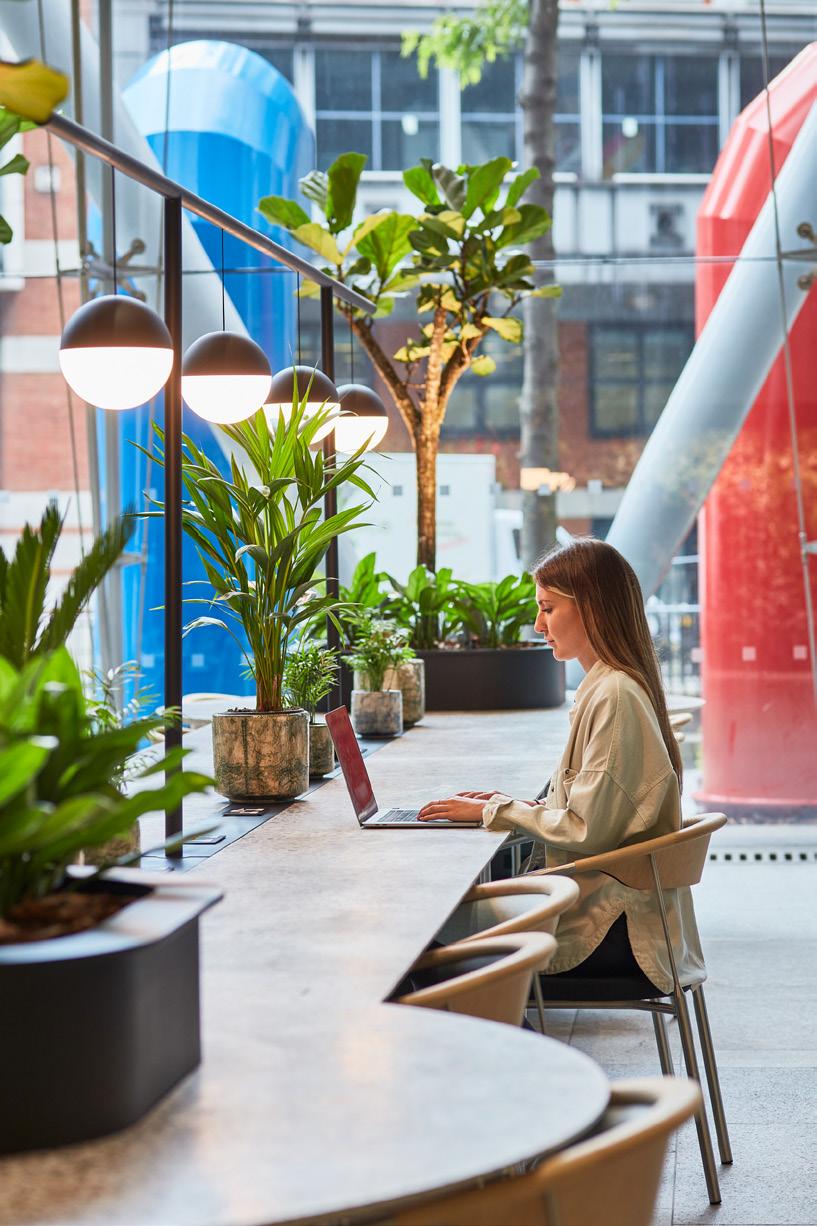
trade associations have myriad roles and responsibilities, but the most crucial is being able to satisfy the needs of their largest members, whilst simultaneously meeting the equally important requirements of those who are SMEs.
GAMBICA is clearly performing sterling work on behalf of both large and small, with numbers at an all-time high, an impressive programme of events (both virtual and in-person) in the UK and overseas, and a fast-growing bio-tech membership.

With members working across the industrial automation, process instrumentation and control, testing and measurement, lab technology and university sectors, it's a varied and intense schedule.
November's Lab Innovations exhibition at the Birmingham NEC is a calendar highlight, as the only event for the whole UK lab sector, but the association's activities go much further afield.
“In October, we're taking members to Johannesburg for Medlab Africa 2022, in November, we're at Medica 2022 in Dusseldorf, and we're already making plans for Medlab Middle East 23 in Dubai in February,” says Jacqueline Balian, who heads GAMBICA's lab, test and measurement sectors.
She's based at the organisation's head office in London's Thomas More Street, but is more likely to be found at shows, events and trade events in the UK or overseas.

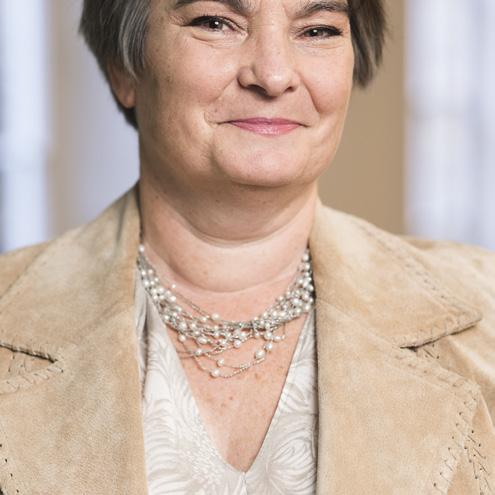
“Everything we do is about bringing members together, helping them exchange information with each other, and collecting and collating data from our industry contacts here, and around the world, so we can better inform them,” says Balian.
“Supply chain issues, particularly related to the shortage of microchips, are posing significant challenges for many members, and in September, we held a webinar so a specialist in product design could present his thoughts about how to combat those issues.

“Members are generally optimistic about the medium-term and into the future, but are understandably wary about how to best source materials, compounds and other essential supplies in the short-term, especially those they need to develop their next-generation products.
“I've always found people in our sectors to be both convivial and keen to collaborate. Some are competitors, but that doesn't prevent them working together at multiple levels, from PR and comms to purchasing.”
Around 30% of GAMBICA's members export products and services, so trade missions are a core activity, and it's quite usual for them to attract between 30 and 40 companies.
“A lot of SME members are keen to travel to meet existing and potential customers, so we arrange their stands, exhibition space, freight carriers and even their graphics, so they can focus purely on their business,” says Balian.
“Some need assistance with their travel arrangements or export documentation, but we've been doing this for a long time, so it's become second-nature.”
GAMBICA also uses its expertise in data-gathering, from members and external sources, so the members can learn about the scale of the market in which they operate, the size of their share and the latest influences impacting trading patterns and trends.
“Everyone finds this information useful, but particularly those whose parent companies are based in the US. For some reason, their market data isn't always terribly accurate, so they appreciate being able to see the real picture,” says Balian.
Like all trade associations, GAMBICA is resolutely apolitical, but many members are unhappy about the loss of funding from Horizon Europe, the EU's key programme for research funding and collaboration, and the post-Brexit complexities of importing and exporting.
“We are pressing the new government on plans to replace the EU funding and making the case for simpler customs regulations especially on inward and outward processing,” says Balian.
“Since the UK lost access to Horizon Europe grants, we have been losing brilliant researchers, committed teachers and entrepreneurs who have decided to relocate abroad.
“Throughout Europe, the quality of the UK's work in calibration services is renowned, but the inward and outward processing procedures are so onerous, that I fear some companies will simply leave the sector and others will be forced to either set up overseas hubs or relocate within the EU.
“Whatever the issue, there is always a way around it and our members are great at sharing their solutions – whilst we press the government to get the basics right.”
For more information about GAMBICA, please visit: www.gambica.org.uk







of
for
including
the Lab Innovations' show at the Birmingham NEC in November will showcase products and services from around the world, but one of the most intriguing exhibitors doesn't have too far to travel.
Microbiological start-up Cytecom, whose revolutionary CyteCount machine will be on show for the first time in the UK, is based in The Venture Centre, on the University of Warwick's (UoW) science park in Coventry.

The emerging start-up was founded in 2018 by James Stratford and Munehiro Asally, whose doctoral studies in life sciences at the UoW were the catalyst for a new technique which has dramatically slashed the time taken to count living bacteria.

For the past 140 years, bacterial culture has been the microbiology ‘gold standard’ for counting live bacteria. It involves growing bacteria in petri-dishes and then laboriously counting the number of bacterial colonies, known as the 'plate count' method.
“It is a very time-consuming and troublesome procedure, because at the

very least you have to incubate the bacteria overnight, you often have to wait two days, and in some cases, it can take a month to get the results you need to proceed,” says Dr Karlikowska. “Using the CyteCount machine developed from James and Munehiro's research, which uses electrical impulses to count bacteria, you have all the information in just 30 minutes.”
One application of the technology is clinical diagnostics. The machine can help combat a major public health threat, bacterial antimicrobial resistance, which occurs when the bacteria which causes infection evolves
and changes, so that it is no longer killed by the drug treatment.
“In terms of diagnostic testing, the machine tells you the cause of infection and which drug will be the most effective, so the data it provides will ultimately reduce the number of unnecessary antibiotic prescriptions,” says Dr Karlikowska.


“CyteCount saves time and money, whilst increasing productivity, which is crucial to the NHS, and researchers really appreciate it because it reduces their workload and cuts their overheads, as they don't need to use as much expensive lab space to reach their conclusions.
“It's a very simple system, which also has an intuitive interface, and because it's only the size of a shoebox, it's as mobile as could be. We've also installed a battery pack which provides enough power for eight hours of continuous testing.”
However, as so often with innovative and early-stage research, the founders’ initial idea for turning their academic discovery into a commercially viable product hasn't evolved as originally conceived.
They initially planned to build a machine to control bacteria through electrical stimulation, believing it would add value to university research labs,
manufacturers of antibiotics and companies developing probiotics.
To find out if their product would have a market, James and Munehiro applied to the Innovation to Commercialisation of University Research programme, which awarded them funds to travel to meet potential customers.
“James went to conferences and exhibitions in the UK and overseas, but discovered that researchers and companies were not interested in controlling bacteria. Instead, they
were very interested in a machine which could 'count' living bacteria in real time” recalls Dr Karlikowska.

The last six months saw Cytecom scale up to refine its machine, strengthen its in-house capabilities, and begin seeing if its commercial potential could be realised.
“We have only started bringing the CyteCount to the UK market and it's already been very well received by everyone who has seen it, and we've made a significant number of sales to microbiology companies and researchers,” says Dr Karlikowska.
“In the medium-term, we'll develop a sales presence overseas and will also look to set up partnerships with organisations who could use it as a diagnostic device, such as the NHS.”
Cytecom is now looking to recruit a new product specialist, to build on the success of the CyteCount and a technical expert to identify ways in which more information can be extracted from its data.
Dr Karlikowska says the company is very appreciative of the backing it has received from the academic and scientific community in and around Coventry, which has been pivotal to its creation and its success.
“We all like it here, being in the middle of the country makes sense from a logistical perspective, and the support and guidance we have received from the university and its partner organisations has been tremendous.” ■
For more information about Cytecom, please visit: www.cytecom.co.uk



The RightCycle™ Programme has diverted over 1,600 metric tons of waste globally since 2011. That’s equivalent to the weight of 400 African elephants! Start your sustainability journey today by recycling Kimtech™ nitrile gloves and apparel. Visit www.kimtech.eu to learn more.






“ I N T e R m S O f DIA g NOSTIC T e STIN g, TH e
C y T e COUNT m ACHIN e T ell S y OU TH e CAUS e O f IN fe CTION AND w HICH DRU g w I ll be TH e m OST effe CTI ve, SO TH e DATA IT PRO v ID e S w I ll U l TI m AT ely R e DUC e TH e NU mbe R O f UNN e C e SSAR y ANTI b IOTIC PR e SCRIPTIONS ”
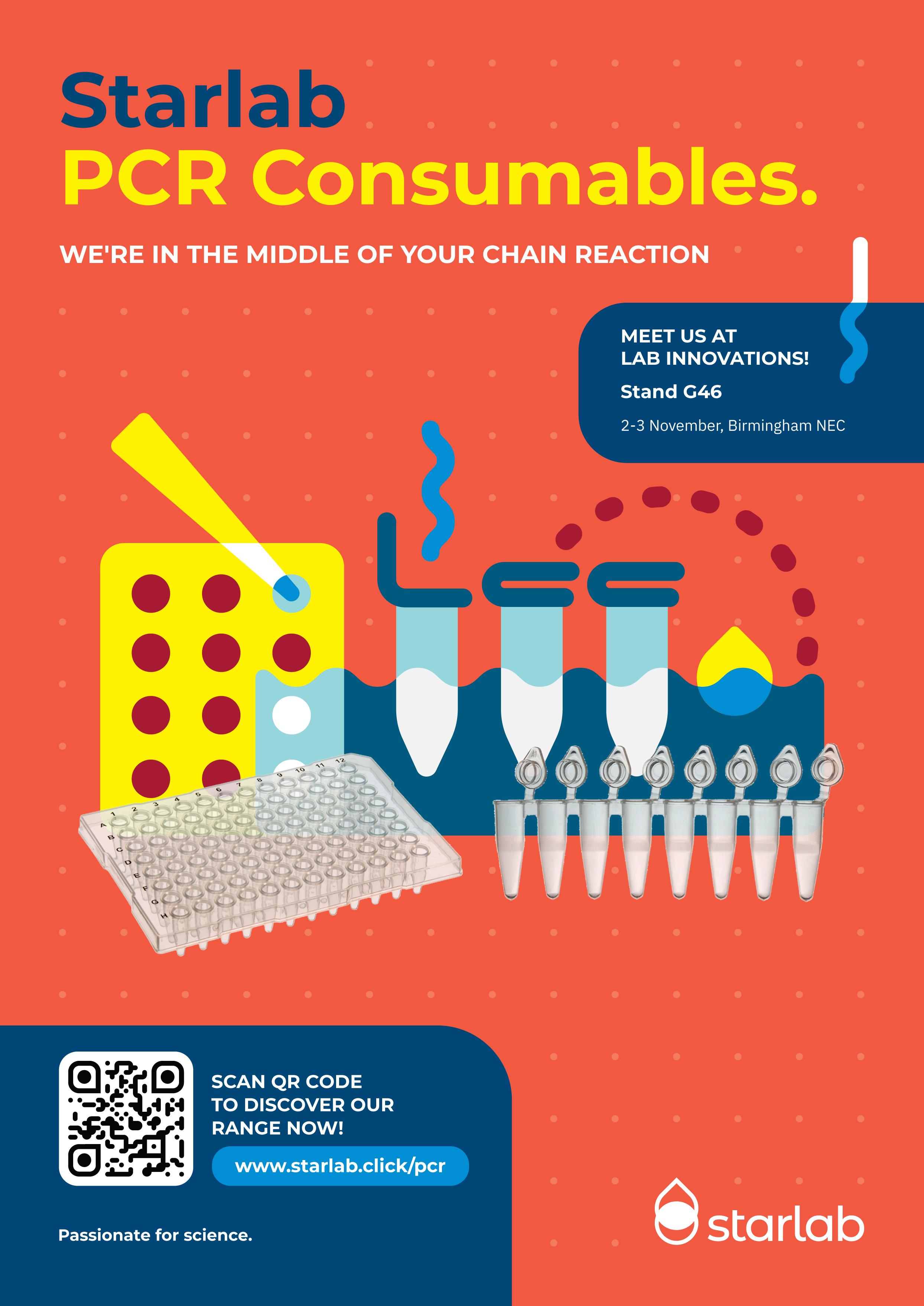
ife sciences has long been a sector to watch for astute observers and investment analysts from the real estate industry.

However, the remarkable achievements of the UK's vaccine manufacturers, researchers and their peers during the pandemic also made it a prime target for the global venture capital community.
Now, whether your preferred source of financial news is Sky, Bloomberg or Weibo, all the chatter is about the so-called 'wall of money' heading for these shores.

Discovering authoritative analysis and commentary behind the headlines is less easy, although Savills' annual 'Life Sciences: ‘Trends & Outlook' does stand out from the herd.
Lang leads its global coverage of the sector, supported by colleagues in China, Switzerland and the US whose insights inform the work of the London-based team, which also covers life science investment, planning and data.
Savills' May 2022 report confirmed that the world's top locations for venture capital raised by life science companies were still the BostonCambridge corridor in Massachusetts, followed by Shanghai, San Francisco, San Diego, New York and Beijing.
From a purely UK perspective, it was pleasing to note that Cambridge ranked
ahead of both Shenzen and Seoul, with London and Oxford also high up the top 20 table, and both still ahead of Seattle and Nanjing. Savills' next report isn't scheduled until Q4 2022 though, so it's timely to ask Lang for his thoughts on the sector's UK growth prospects from a real estate and investment perspective.
“We're still seeing a huge amount of real estate capital in the market chasing a limited amount of space, and an equally small number of opportunities,” he says.

“The most recent figures I saw from my colleagues on the investment side indicated there was between £10 billion and £12 billion looking to access life sciences, although those numbers will rise with every update.
“As always though, when the capital market slows down, there'll be an impact across the whole real estate market, and at some points, everyone seems to pause for breath to see how it's going to pan out.
“We're seeing new investors and funds looking to access life sciences in core locations and wondering how best to do so. Understandably, it tends to take them more time to identify suitable opportunities.
“You have to do your homework, understand the local and regional eco-systems, talk to the right people, collate and study data, and carry out serious amounts of due diligence on potential acquisitions to decide if you're going for the correct type of space in the right location.
“Simply buying stock because it's being promoted as 'life sciences' will lead some investors astray. They'll think they can turn that space around and create something brilliant.
“However, there is a larger degree of patience required to create successful ecosystems and not all investors will be able to commit to the longer-term required.
“There is also a tendency, particularly when someone is coming from the US or the Far East, to group all areas of the UK together. Just because it works in the Golden Triangle, does not mean all types of life science ecosystems will work anywhere.
“Investors need to be aware, of course, before they consider where to put their money that some locations will need more commitment, and quite likely, more capital.”
The question of which locations to support is also a crucial challenge for the new Prime Minister and Chancellor, particularly with regard to their party's oft-mentioned 'levelling-up' agenda.

Lang cites a report from the House of Lords' Science and Technology Committee, (which gained minimal attention as it was issued in early August), that considered issues around the government's stated ambition to make the UK a science and tech super-power.
“They pointed out that the Office for Science and Technology had defined health and life sciences as one of four priority investment areas for the incoming government,” he recalls.
“I really hope that, when Liz Truss and her advisers come to discuss potential spending plans, they realise it's taken decades to grow the scale and reputation of the Golden Triangle.
howard Group is constructing 90,000 sq ft of wet labs at unity campus, south cambridge, with completion due summer 2023

“Ministers can't expect that new investment in life sciences in other cities will have an immediate impact, and they must also continue to invest in that area to maintain its status as the UK's pre-eminent location for research and innovation in that sector.
“I’d prefer to see a ‘powering-up’ of life science locations across the whole of the UK. Over half of the UK employment in life sciences is outside the South-East, London and Eastern regions.
“We need to grow this employment from Bristol to Aberdeen and everywhere in between, but at the same time ensure the Golden Triangle isn’t tarnished.”
Within the sector, Lang highlights the huge potential of bio-manufacturing sector, which ensures that the whole life science supply chain is present in the UK.
He identifies one crucial element as the need to engage with, and support, the network of Catapults, which drives innovation and helps to create the appropriate labour pool.
Lang is particularly enthused by the UK's potential to deliver hi-tech industrial space and advanced manufacturing facilities to match the fast-emerging requirements of life science companies for R&D, testing and manufacturing purposes.
He says such provision will ensure that as many areas of the life science sector are catered for as possible, not just chemistry and biology labs, but also high-value manufacturing, particularly within the med-tech sector.
Lang looks at other countries in Western Europe, notably Switzerland,
who are planning to scale up their bio-manufacturing capabilities, but says such opportunities haven’t yet acquired similar traction in the UK.
His recent discussions with leading global architectural practices highlighted the importance of design for all life science companies, and he was intrigued to see concepts tailored to the very specific needs of laboratory workers, specifically life science R&D teams.
“It's a point which should be well understood by those new to the sector, that not all space can be repurposed for life science uses and design of new space must be considered carefully” says Lang.
“The architectural industry must continue to demonstrate what is required to potential developers and would-be investors early in the process, because their knowledge is vital.”

Looking ahead, Lang predicts an upsurge in pre-lets early in 2023 and throughout the year, as the new space which began to be developed during the pandemic reaches the market.
“The market in the first nine months has been occupier-driven, and I think the full-year take-up in life sciences will likely be a little below the expectations which we had at the start of 2022,” he says.
“I'm not overly concerned though because that's down to the shortage of supply rather than an absence of demand, and I think we'll then see a significant increase in the amount of available space.
“As we go through 2023, 2024 and quite likely into 2025, we'll see a large number of life science companies occupy larger chunks of space because the right kind of space has come forward.
“We'll also start seeing deal transactions completing as companies access the wall of capital, about which so much has been said over the last couple of years, to achieve their ambitions. They'll have the money and the space, and now they'll finally be able to focus on the science.”
Lang is also bullish about hopes for a second and equally significant wave of potential funding to come to the UK.
“We'll see a period of sustained growth for the smaller companies, the SMEs and start-ups who began life during Covid, because they've had time to fine-tune their models and are now delivering even better science, which in turn will attract a new influx of capital,” he says.
“Even the word 'science' itself will take on new forms in the next couple of years, notably around all elements of human health and wellbeing, because the pace of innovation in life sciences is quite remarkable when both the funding and the space are there.” ■
More detail about the UK’s life sciences’ sector can be found in Savills’ 2022 Life Sciences: ‘Trends & Outlook’ report at: www.savills.co.uk/research_ articles/229130/328386-0





Th e compact and smart new LCMS-2050 upgrades y o u r ability to create exceptionally fast and precise m a ss spectrometry analysis. It ensures that your lab i s on the cutting edge of performance now, and f o r years to come.


f o r years to come.


E n h anced sensitivity d elivers more accurate analyses and inspires greater c o nfidence
E n h anced sensitivity d elivers more accurate analyses and inspires greater c o nfidence
Robust reliability provides dependable peak detection and simplifies m a c hine maintenance www.shimadzu.co.uk/countless-benefits
Robust reliability provides dependable peak detection and simplifies m a c hine maintenance www.shimadzu.co.uk/countless-benefits
Rapid polarity switching generates more data through fewer runs and enhances productivity
Elevated peak sampling rates refine data quality and augments peak integration
Elevated peak sampling rates refine data quality and augments peak integration
Easy to use simplicity puts this high end lab performance device in a class of its own
Easy to use simplicity puts this high end lab performance device in a class of its own


In recent years cybercriminals, activists and nation states have increasingly targeted the intellectual property (IP) and personally identifiable information (PII) that resides within research institutes, universities, the healthcare sector, and high-tech companies from start-ups to multinationals. This increase in cyber threats has been driven by attackers understanding the worth of data and different ways of monetising it, an increase in political tensions across the globe, and the Covid-19 pandemic.
There have been a number of attacks on universities such as Oxford that have made the front pages of the national press1, 2 including that British security services provided protection to Oxford University Covid research2. Successful cyber-attacks cause tangible and intangible losses to the victim and can extend to their clients and employees. Ransomware has been found to have double and triple threats. First, the cybercriminals demand a ransom to unencrypt the data they have taken hostage. Next, they demand an additional payment to prevent them releasing data they have exfiltrated from the victim’s systems. Finally, the cybercriminals occasionally contact the individuals whose personal data has been compromised and demand a ransom to stop them releasing it
into the public domain or selling it on the dark web3.
Cyber security is basically about preventing issues from occurring and recovering from them afterwards. A serious cyber incident can spark disaster recovery and business continuity issues for an organisation. Cyber resilience is about rolling with the punches and responding as the cyber incident occurs to keep the organization operating in some form of capacity to reduce impact and improve recovery time. It is about preventing issues becoming events that seriously affect your business.

Whenever I start talking about cyber security especially with new clients, I explain that security is about enabling an organisation to meet its business mission in a secure way, it is an enabler not a disabler of the business. Security in its basic form of the CIA triad (Confidential, Integrity and Availability) implies that data and systems should be available to those authorised to have access, whenever they require access, and that the data or systems can only be changed by authorised persons. This implies resilience in the access to ensure availability when required and restrictions to those authorised. The Information Commissioner’s Office (ICO) describes a breach of personal data in the following terms:
A personal data breach will have occurred whenever any personal data is accidentally lost, destroyed, corrupted or disclosed; if someone accesses the data or passes it on without proper authorisation; or if the data is made unavailable and this unavailability has a significant negative effect on individuals 4
It is important to note with GDPR and data protection regulations, that loss of availability of personal data is considered by the ICO as a data breach4. Availability issues along with loss of data are issues the ICO is interested in and will take action over. For example, a ransomware attack might encrypt medical records data, making them unavailable to healthcare professionals, without the data being exfiltrated. In this scenario, the data has not been lost but access to it by authorised persons has been denied, which might result in negative outcomes for patients.
The working environment has changed for many individuals and organisations with remote and hybrid working being more acceptable. Additionally, better plans for switching from office based to remote working has given many businesses a wider scope for responding to situations.
Furthermore, the proliferation of Cloud-based IT services has meant many businesses have moved away from on-premises infrastructure to a Cloudbased or hybrid-based model which can affect the connectivity component of many businesses IT operations. No longer do users need to be on site to do their work, instead they can access Cloud services from wherever they are currently based.
However, for many tenants at science parks there could still be significant amounts of on-premises specialist infrastructure that must be accessed whether users are in the premises or remote or conversely, they have a large Cloud- based computational platforms that must be securely accessed. This makes the resilient delivery of network services across the campus a priority for the operators of the science park.
Threats to the network connectivity are not just equipment failures, power outages or broken cables. Threats to networks can be disruptive with DDoS (Distributed Denial of Service) attacks against tenants on a science park having the potential to swamp the internet link to the whole park.
Additionally, network attacks against equipment can cause the equipment to enter a failure mode and deny the passage of traffic creating a denial-of-service attack. Attacks may affect the whole park, a single tenant and can range from complete system outages to performance of the connection being affected.
To understand how cyber resilience applies to a business, that business needs to complete a Business Impact Analysis (BIA) to understand the importance of assets and the processes that access them to the operation of the business. Your business needs to understand exactly what systems must be maintained to deliver basic functions to continue operating. For many Science parks it is the delivery of services to the tenants of the park and that includes connectivity to the internet.
An additional risk for science parks is that a new tenant might increase the likelihood of a cyberattack. For example, companies involved in cyber security, life sciences, pharmaceuticals, and the defence industry can often be the targets for activists, nation states, competitors, and criminal gangs. Each threat actor has their own motivation and attack methodology, but increased attacks increase the risk to the campus network and disruption to tenants.
TAKEA w A y Science parks and tenant need to conduct a BIA to understand their requirements around the availability of internal and online access and determine the level of cyber resilience. Once this has been completed there needs to be a partnership between the science park, tenants, internet service provider (ISP) and IT managed service providers (MSP) to implement cost effective solutions to achieve the required resilience levels. A core tenet of cyber security is to know what needs to be protected, its value, and to apply the appropriate controls. The same is true for Cyber Resilience. ■
1 https://www.thetimes.co.uk/article/ university-secrets-are-stolen-bycybergangs-oxford-warwick-anduniversity-college-london-r0zsmf56z
2 https://www.thetimes.co.uk/article/ vaccine-hack-was-detected-by-spieswho-saw-it-coming-jfzpxmcxh
3 https://www.bbc.co.uk/news/ technology-54692120
4 https://ico.org.uk/for-organisations/ guide-to-data-protection/guide-to-thegeneral-data-protection-regulation-gdpr/ personal-data-breaches/
For more on Modern Networks, please visit: https://modern-networks.co.uk
the London BioScience Innovation Centre (LBIC) offers lab and office space as well as a virtual service in a central London location at the Royal Veterinary College (RVC).



Founded in 2000, LBIC is home to around 60 physical and virtual clients, ranging from micro businesses to multinational corporations. Since opening, LBIC has supported over 200 companies, some of which have progressed to their own premises, multiple locations and flotation on the stock market. Many clients are working in drug discovery and therapeutics, with others working in diagnostics, med tech and clean tech. LBIC offers flexible terms, allowing companies to grow at their own pace.
LBIC is committed to improving sustainability across its operations and is collaborating with clients to become carbon neutral and reduce environmental impact. LBIC also works with the local community to make a meaningful economic and social contribution.
Just ten minutes’ walk from King’s Cross and St Pancras International stations in central London, LBIC’s location offers outstanding access to domestic and international transport links. LBIC is part of the thriving King’s Cross Knowledge Quarter, which includes over 50 worldleading research institutions and organisations within life science, technology, and the arts. Other notable members include Google, Astra Zeneca and the Francis Crick Institute.
LBIC has over 28,000ft2 of lab and office space, plus access to meeting rooms and the incredible Lightwell café in the RVC, which features elephant and ostrich skeletons.
The Category II laboratories feature temperature control, integrated gas piping and Class II microbiological safety cabinets. LBIC’s sterilisation suite provides a full package to lab clients including clinical waste disposal, glass washing, media autoclaving and access to distilled water.

LBIC’s virtual client facility provides a low-risk option for companies to establish a London base, with services including telephone answering, mail redirection, access to networking events and discounted meeting rooms.
The knowledgeable team work hard to ensure that LBIC meets client needs beyond reception services and lab support. The Business Support Network brings together specialist advisors to offer clients their expertise in areas such as finance, law and recruitment. Clients also get a one-year Gold membership of a networking organisation as well as complimentary passes to conferences and events, some with speaking opportunities.
LBIC also promotes client news and offers a web page for each client.
As a wholly-owned subsidiary of the Royal Veterinary College (RVC), LBIC facilitates collaboration opportunities with
world-leading researchers, as well as providing access to specialist equipment, student placements and contract research services. Founded in 1791, the RVC is a research-led institution, with the Research Excellence Framework 2021 scoring 88% of its research as world-leading or internationally excellent. The RVC is top of the QS World University Subject Rankings 2022 in veterinary science. ■
For more, please visit: www.lbic.com, call 020 7691 1122 or email: lbic@rvc.ac.uk
The laboratory or clean room environment often represents the heart of the GMP manufacturing operation or provides a setting for testing or research. To operate as a functional unit, the laboratory itself requires a number of utilities and a surrounding building infrastructure to support the operations within them.
Scitech has extensive experience in the design, installation and CQV (commissioning, qualification, and validation) of laboratory facilities, designed to both cGMP and non GMP and involving the installation of highcontainment and associated QC facilities. Many of our engineers have worked clientside and are specialists in their own field with extensive knowledge of the regulatory framework and international standards. We have a strong reputation within the life science and technology sectors through our customer-centric values.
Our team will work with you to help to solve your challenges. We are process-driven in our approach and follow a requirements-led staged delivery model with verification through from definition of requirements to delivery of solutions.
Our services span the full sector spectrum, including:
• Master planning
• All design stages from feasibility to detailed
• Production equipment specification
• Financial appraisals
• Planning advice
• Environmental, health and safety consultancy
• Site and system appraisals
• Project strategy and planning
• Procurement, project and
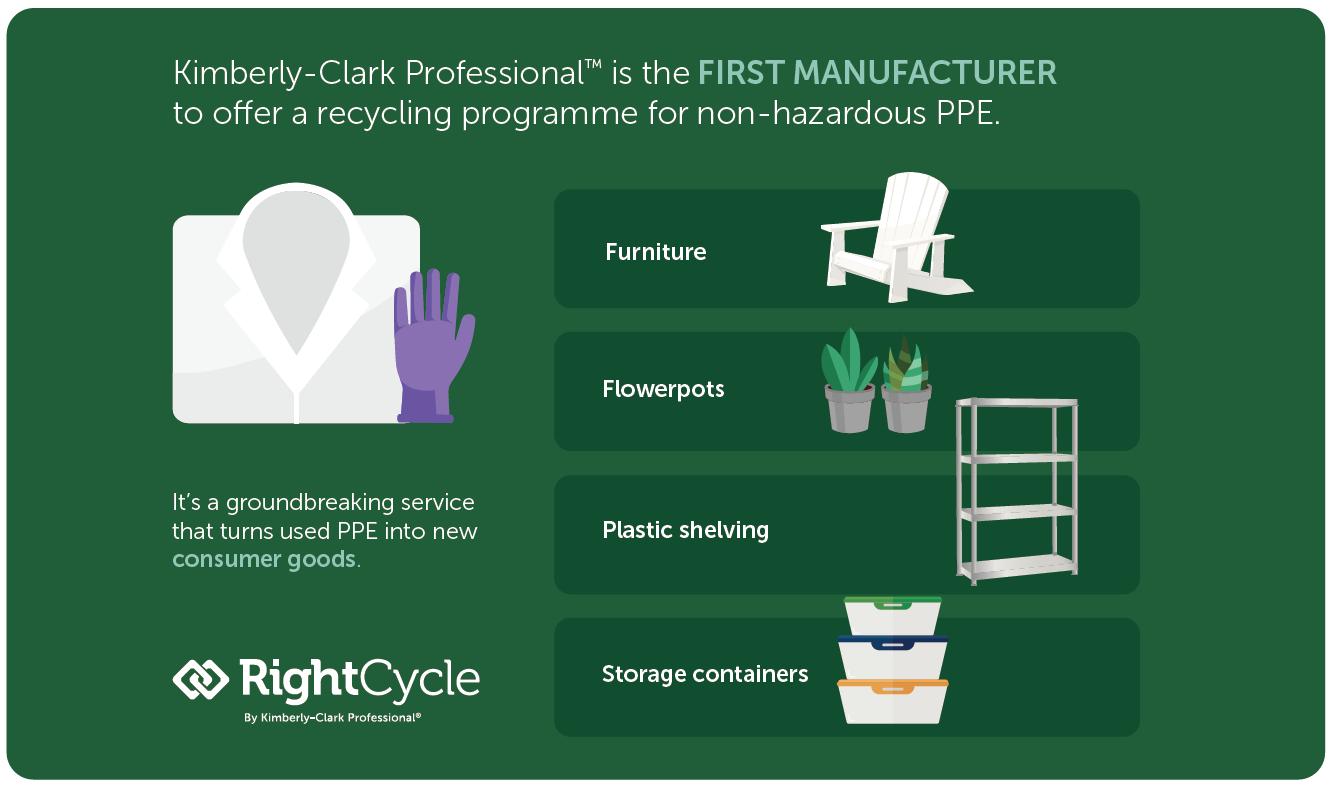
if you use nitrile gloves or single-use apparel items, you can divert them from landfill and give them new life through The RightCycle™ Programme.
This groundbreaking service was launched by Kimberly-Clark Professional™ in 2011. It is the first manufacturer-led programme to turn previously hard-to-recycle items into new consumer goods. In the decade-plus since its inception, the programme has helped divert more than 1,670 metric tons of waste globally from landfills and there are currently more than 900 customers in the programme.
Until The RightCycle™ Programme was launched, there was no large-scale solution for recycling used PPE. As long as the PPE is non-hazardous, it can be recycled through the programme. The items are shipped to recycling facilities where they are sorted and processed into plastic pellets and then molded
into flowerpots, patio furniture, plastic shelving and other products.
The RightCycle™ Programme is easy to implement and will provide you with ongoing reports and metrics on your waste diversion efforts. Every year, programme participants who divert significant amounts of solid waste from
construction management, commissioning management, safety consultancy.
Our embedded quality and regulatory understanding supplements our design and engineering consultancy capability.
Whatever your needs, perhaps a new laboratory or manufacturing plant, a process analysis or upgrading existing facilities, investing in our consultancy services at an early stage will ensure that your project will deliver your desired outcomes in line with the costs and timelines that you expect. ■
To find out more, visit, www.scitech.com
landfills are recognised with the Chelsea Santucci Greenovation Awards.
The RightCycle™ Programme is currently available in the U.K., Ireland, Germany, France, Belgium, Austria and Spain and is open to all companies that use or want to use Kimtech™ branded apparel items and nitrile gloves in non-hazardous applications. ■
For more information on The RightCycle™ Programme, please visit: www.kimtech.eu
 AdVERTORIAL SPONSORED CONTENT
AdVERTORIAL SPONSORED CONTENT
Unity Campus is an exciting new urban innovation district in the heart of the Cambridgeshire countryside.
Campus owners Howard Group, a Cambridge-based family business with a 50-year track record as a long-term property investor and developer, is transforming the site of a former tannery into a stunning modern workplace.
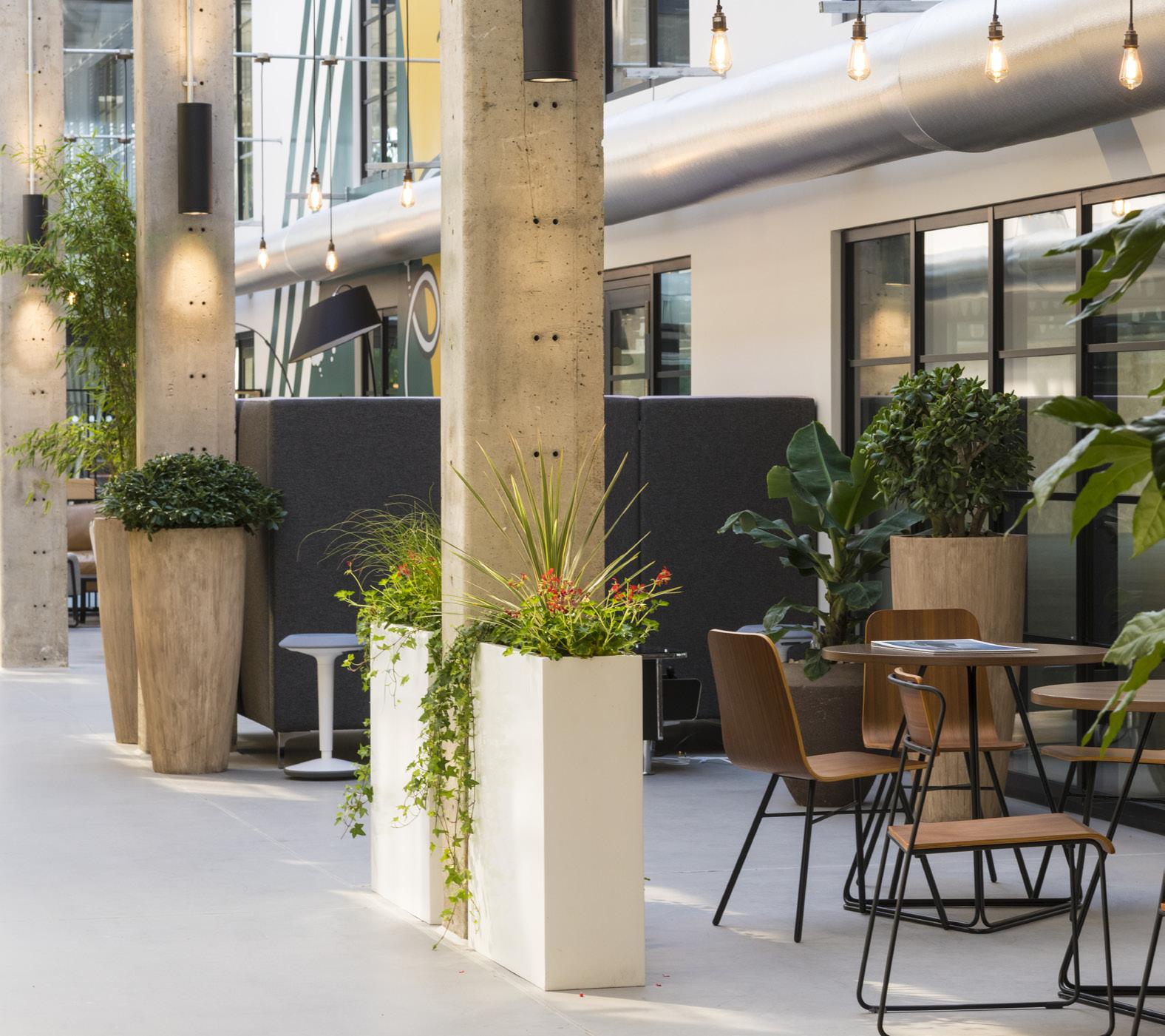
Located 8 miles south of Cambridge, the 11-acre Campus which is already home to 12 leading life science and technology companies, is undergoing a major expansion. Three new laboratory buildings are due for completion by the end of 2023 and a further three buildings by the end of 2025 providing an additional 150,000 sq ft of floorspace. Other out-dated industrial units have been sustainably repurposed into state-of-the-art offices and laboratories adjacent to a well-equipped fitness centre. Howard Group is supported in this exciting next phase of development
by a dedicated and highly experienced professional team which includes Nicholas Hare Architects, an award-winning design practice with over 30 years’ experience in the delivery of life science facilities for both industry and academia; and 3PM - project managers with an exceptional, long-established reputation in the delivery of complex projects across a range of sectors and specialisms, specifically life sciences.
The masterplan for the compact site has been purposefully designed to foster business interactions and friendships.

Building on the industrial legacy of the nearby villages of Sawston and Pampisford, the bold urban aesthetic of the buildings is being offset by a network of connected green spaces and water meadows as well as a landscaped courtyard with a multi-purpose clubhouse.
Community, societal impact and sustainability underpin every aspect of the operation and development of the Campus.
By merging the traditional and modern, urban and rural, business and social, Unity Campus offers an entirely different working environment to all other science and research parks in the Cambridge area, creating a wider choice of location for technology and life science companies seeking laboratories or offices. ■
For further information, please visit: www.unitycampus.co.uk
established in 1935 and with headquarters in the centre of Cambridge, Howard Group is a leading regional property investor and developer with a property investment portfolio of £200m, made up of 24 properties,1 million sq ft of occupied space and with 88 tenants and counting. The Group is also a collaborative and patient investment partner, supporting the next generation of entrepreneurs developing meaningful, knowledge-intensive businesses.
Howard Group invests in and develops high-quality and innovative places that have a positive long-term impact on the environment and the people in and around them. Whether it’s a state-of-the-art student accommodation scheme, a campus environment specifically tailored to support Cambridge’s burgeoning life science and innovation sectors or an industrial hub positioned within one of the most exciting regeneration and growth areas in London, the Group’s objective is to make sure these places meet the needs of those who interact with them, both now and into the future, leaving a lasting legacy for generations to come. ■
For more about Howard Group, visit: www.howard-ventures.com
Oxford North is a new global innovation district being built on 64 acres of land within Oxford city’s northern boundary.
This new place starts with people, their ideas and ambitions. It’s being built to celebrate and enable them, providing a place for people who want to make their mark on the world.
Oxford North will connect academia and commerce, invention and investment, providing a sustainable place to work, live, learn and socialise.

Oxford North will be a thriving and vibrant new district with innovation and sustainability at its heart.
The project, masterplanned by Fletcher Priest Architects, will deliver 1 million sq ft of new labs and workspaces including a new innovation centre, and 480 new homes.
Around 4,500 people will work there alongside 1,500 residents and who, along with the local community and visitors, will enjoy amenities including a hotel, nursery, shops, bars and cafes, three public parks, and significant investment in travelling around sustainably.
The new district will be a unique home and workplace, for scientists, technologists
and inventors, transforming lives and enhancing one of the world’s greatest cities.
Setting a new standard for placemaking, Oxford North will blend culture with low carbon innovation, sustainability with leisure, and open spaces with science. It offers a new model for the future, supporting business, enabling discovery and, above all, improving lives, all in one place.
With access to wide open public spaces and public art throughout, Oxford North is configured to enhance wellbeing. The landscape is designed to enhance biodiversity across the newlycreated public parks and facilitate access to nature for residents and visitors.
Woven into the new public parks are spaces for entertainment, events and
exercise. Integral to the plans are areas for families and children to enjoy natural play while opening eyes and discovering the future. At every turn there will be opportunities for enjoyment, delight and new perspectives. ■
Oxford North is being delivered by Oxford North Ventures GP LLP, a 50:50 commercial joint venture partnership with St John’s College’s development company, Thomas White Oxford, and Cadillac Fairview with Stanhope. The first new homes are being delivered by Thomas White Oxford’s residential partner, Hill Group.
For more, visit: www.oxfordnorth.com or please email: info@oxfordnorth.com
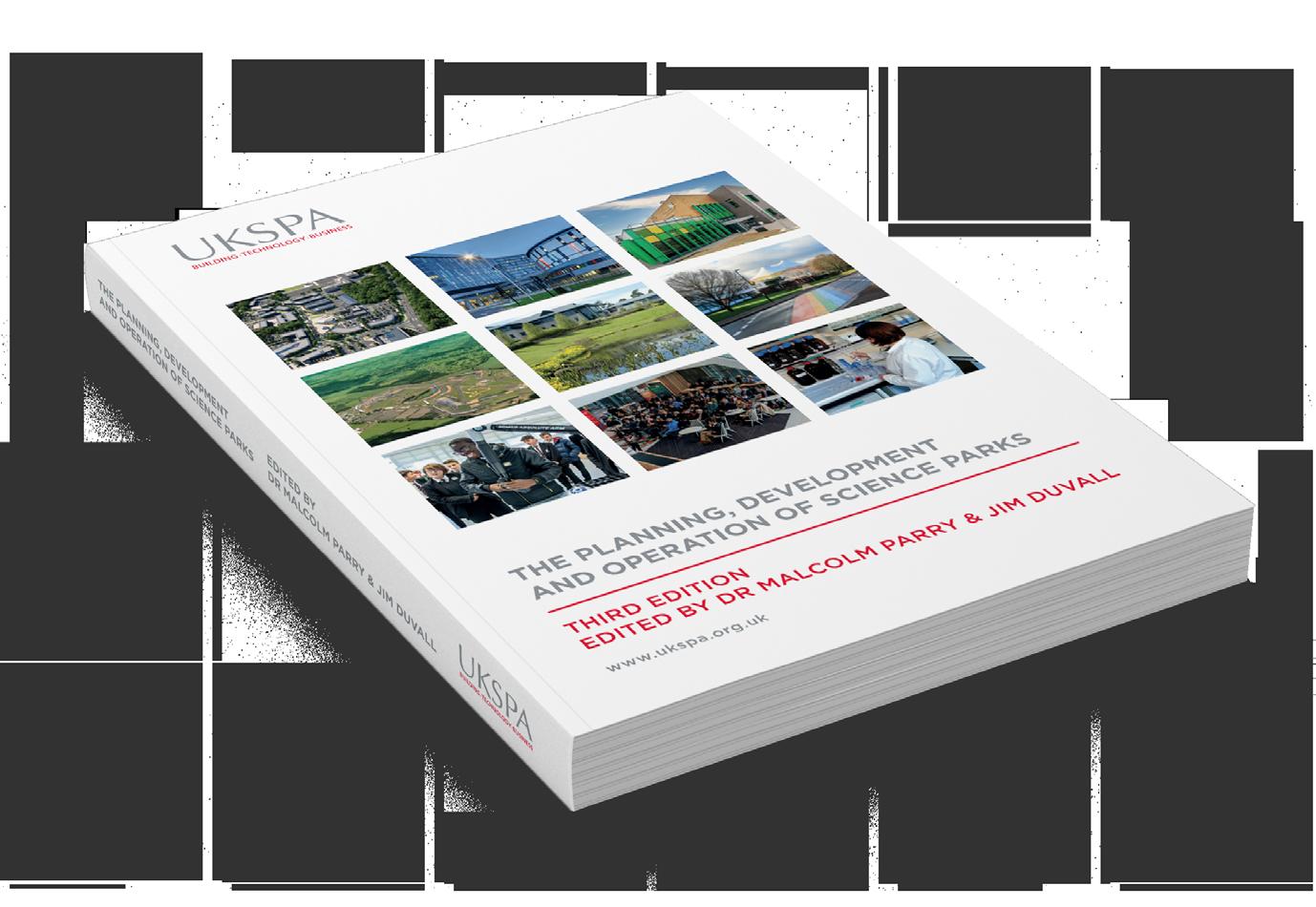
Announcing
The Planning, Development
The
by a
Operation
of
on the
at
case
As Derbyshire proudly points out, Apple's occupation of 80,000 sq ft of Grade A space at 30 Station Road means the scheme is now home to three of the world's trilliondollar enterprises, after the earlier arrival of Amazon and Samsung.

hen Apple finally occupies its shiny new research and office hub in Cambridge in the coming weeks, the ghost of legendary architect Lord Richard Rogers will be looking on and nodding approvingly.
Back in 2005, he recognised that the increasingly shabby and unloved area around the town's Central Station could be transformed into an imposing mixed-use district to rival anything the UK had to offer.
It has taken so long to deliver his visionary CB1 masterplan on behalf of Brookgate Land for myriad reasons, not least a recession and the fluctuating requirements of the local office market.
Another major obstacle, particularly in the early years, was an alliance of Cambridge dons, eco-warriors and NIMBYs, all firmly convinced they had right on their side when opposing the proposals.
However, throughout the 17 long years, Bidwells' Mike Derbyshire was a constant presence as both a doughty warrior and compelling advocate on behalf of the CB1 cause.
He met the late Lord Rogers right at the start of the planning process, when the original proposals were rejected by a daunting tally of 26 separate grounds.
Undeterred, Derbyshire and his colleagues managed to steer the scheme forward via years of consultation and collaboration, underpinned by Brookgate's innovative funding model and risk-sharing partnerships, until the CB1 concept was acclaimed by all.


Given his intimate knowledge of the planning and development landscape, it's intriguing to hear his thoughts on how the UK might become a science super-power.
The starting point is Bidwells' Life Sciences 2030 report, issued in June, which assessed both the opportunities and the challenges ahead for real estate developers and investors.
It identified biopharma, bioprocessing, diagnostics, digital health and bioprocessing as sectors to watch within the wider industry, but stressed that understanding the need of life sciences' companies for flexible and flexible space was critical, and delivering that space would be crucial.
“The government has recognised that the Golden Triangle is so-called for a reason. Not simply because Oxford and Cambridge are here, but for the tremendous array of funders, innovators, partners. VC houses and others who want to be close to them,” says Derbyshire.
“The presence of established science parks, and the availability of Grade A office space and lab space is also a powerful magnet.
"The big tech companies and the data analysts are also drawn to London, so we have all the ingredients.
Mike Derbyshire, head of Bidwells' planning practice , argues that planning reform is crucial if the UK is to become a science super-power.Microsoft Building at Station road, CB1
“However, we need much more space for advanced manufacturing. If Arm wanted to come here at the moment, for example, we wouldn't have enough space to accommodate them. We simply don't have the real estate or the infrastructure they'd require.”
Research by Bidwells' science and technology team indicates that the demand-supply relationship is significantly out of synch in both Oxford and Cambridge.
Combined demand for business space hit a record 2.8m sq ft at the end of 2021, but there is now no laboratory space at either location, although there is demand for 1.7m sq ft of wet and dry labs.
“We are already missing out on employers who really want to be here because the space isn't available, and of course life sciences' companies are footloose,” says Derbyshire.

“Almost a third of the companies interviewed for our report said they expected to be searching for specialised space in the coming decade, because AI, robotics, machine-learning and automation have changed the ways in which they carry out their research.
“We're headquartered in Cambridge and have clients and contacts right across the Oxford-Cambridge Arc, and it's very clear that the shortages of Grade A offices and modern lab space are already handicapping plans for growth.
“It's tremendous that AZ brought their research HQ here, because they employ around 4,000 highly-trained people in Cambridge, another 46,000 across the UK at their advanced manufacturing plants and there are thousands more in their supply chains.
“ If TH e g O ve RN me NT IS TO D el I ve R ON ITS PRO m IS e S TO TH e TO w NS AND AR e AS 'lef T be HIND ', IT m UST IN ve ST IN SUCC e SS f U l S e CTORS AND R eg IONS TO ge N e RAT e TH e TA x INCO me AND OTH e R R eve NU e IT w I ll R eq UIR e. ” mIK e D e R by SHIR e, H e AD O f b ID well' S P l ANNIN g PRACTIC e
“However, they could just as easily have gone to San Francisco, and the shortage of space doesn't just impact on the decision-making of companies in life sciences. Potential investors, PE firms and venture capitalists who see problems impacting the sector may also decide to look elsewhere.”
Derbyshire bemoans the lack of political will and impetus concerning the issue and is particularly concerned that the government doesn't appear to understand the importance of the knowledge economy, and particularly life sciences, to the future UK economy.
“I thought the case for investment in infrastructure, scientific innovation and advanced manufacturing had been made very clear to everyone during the pandemic, especially given the remarkable achievements in vaccine research and the roll-out programme,” he admits.
“Instead though, whilst we hear grand speeches on the subject from ministers, there is still no sign of the massive investment which is so urgently required.
“I have always been impressed by the way in which successive London Mayors and the Greater London Authority were able to drive major projects forward for the greater good, and we need to see something similar from central government.”
At the regional level, Derbyshire believes that Metro Mayor Andy Street is displaying tremendous leadership skills and being proactive in fighting the corner for towns and cities across the West Midlands.
“I believe it's useful, though not always essential, if a regional mayor has a background in business, so they can speak the same language and understand the mindset of potential investors and corporates,” he says.
“However, what is clearly essential is that we hear from someone in government who can play the same role as Andy Street and London's Mayors, in having clarity of vision, but also in delivering tangible progress in such crucial areas as infrastructure, planning and development.
“There are 33 local authorities across the Oxford-Cambridge Arc, and there are always going to be differing views about the best way to realise our potential as a super-power in life sciences, which makes strong leadership, commitment and investment by government even more important.”
Derbyshire believes the most pressing requirement is to reform the planning system, which he considers no longer fit-for-purpose.
“We need to see substantial amounts of money going into local authorities to ensure they have the resources to deliver a structure which is simplified and far more productive,” he says.
“So much bandwidth in the civil service was soaked up by Covid, which was understandable, but now we have to invest in the innovation economy.
“The government needs to understand the urgency of the challenge, enhance connectivity via the East-West train link between Oxford and Cambridge and to actually invest in the innovation economy, rather than just paying lip-service to its importance.”
Given the present political focus on the 'levelling up' agenda, some might consider it counter-intuitive to make the case for investing in an area which is already hugely successful, but Derbyshire neatly flips that argument around.
“If the government is to deliver on its promises to the towns and areas often described as 'left behind', it must invest in successful sectors and regions to generate the tax income and other
revenue it will require,” he says.
“The new Chancellor and their Cabinet colleagues have many tough decisions to make, but the easiest one should be to commit the resources required to transform our planning system and invest in infrastructure and the innovation economy.”
However, for now, such thoughts are being set aside as Derbyshire and his colleagues focus on the second element of Brookgate Land's ambitious plans for Cambridge.
Having all-but completed the regeneration of the area around the historic Central station, the emphasis is now on delivering the 1.2m square feet mixed-use regeneration scheme, including 700,000 sq ft of offices and labs, at Cambridge North around the new station


It's transformation for a city, whose physical evolution was so long handicapped by the nay-sayers, on a scale of which even Lord Rogers could not have dreamed all those years ago. ■
For more detail about Bidwells and the work of Mike and his colleagues, please visit: www.bidwells.co.uk
i mages c redit: acme
Take a look at Shuttlepouch™- a secondary mailing pack with absorbent for transporting Category B samples
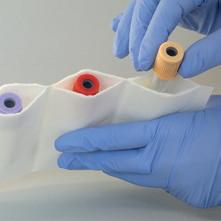
Compared to other 95kPa pouches it can reduce plastic by up to 83%. What’s more, it can be customised to your exact requirements
■ Ideal for transporting individual blood, urine or faecal samples to the testing laboratory and meets UN3373 and P650 Guidelines when used with a rigid outer box

■ Leak-proof pouch with integrated super absorbent sheet minimises packaging time
■ Clear front panel enables visibility of patient details on tube
■ Printed instructions on reverse for convenience and reduces need for printed materials





■ Punch slot opening for easy insertion of tube into pouch
■ Tear notch for quick and safe removal of tube at testing site
Just one of many components available for kit compilation Contact Alpha Laboratories for more information or a quotation for your custom design requirements and join our long list of satisfied customers.

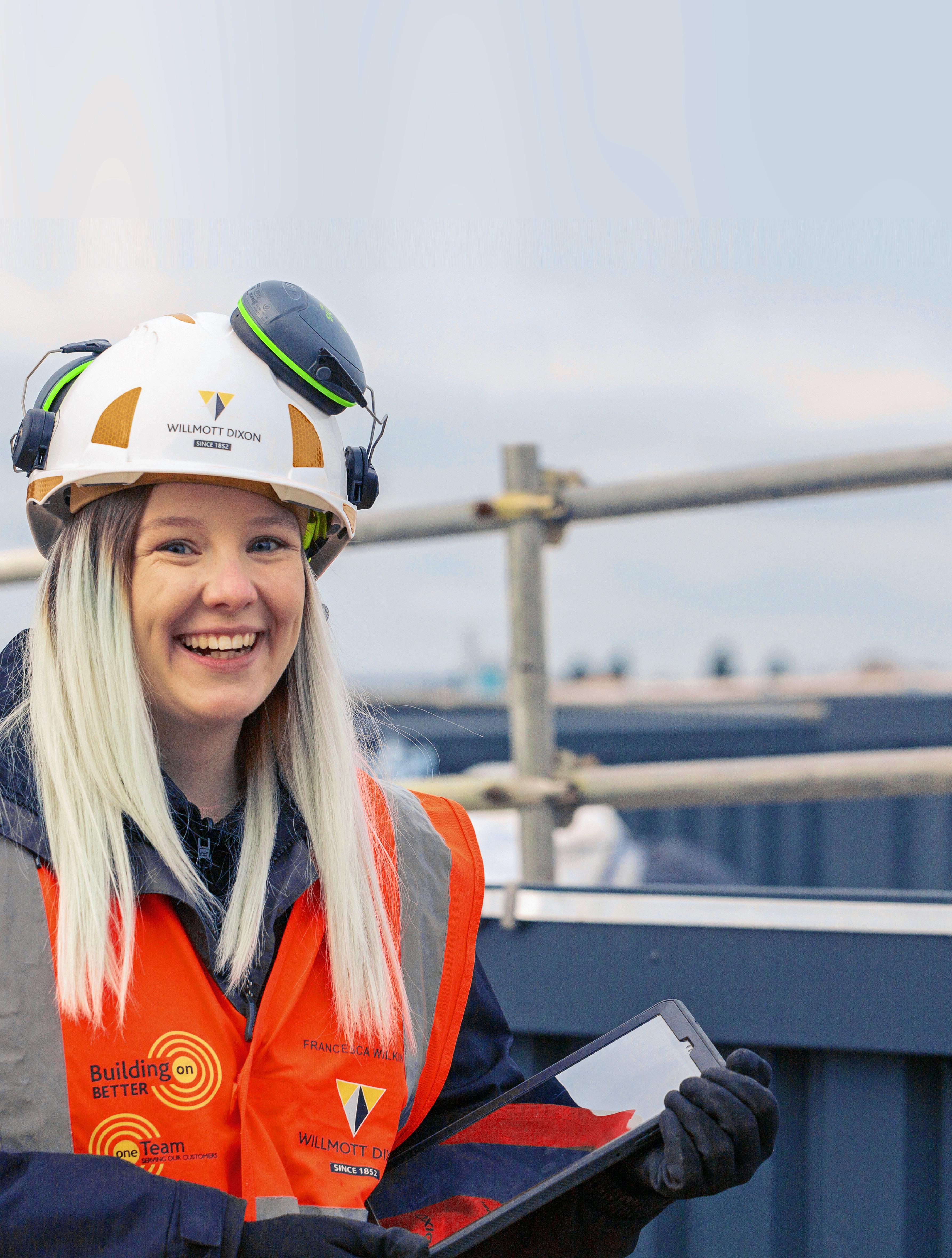
understanding how science buildings should reduce and manage energy consumption is critical at a time when costs are
To sustainably stand the test of time, science buildings need to take several steps to effectively reduce and manage energy consumption –for both new builds and when retrofitting existing facilities.
There are a few ‘basics’ that can be incorporated into new buildings to make them more efficient, such as maximising building orientation to gain natural daylight and selecting a compact shape for the building form that will retain energy better.
Combine that with high levels of insulation and air tightness, and you have a very effective starting point for minimising energy consumption. This approach gives the best long-term gains, and really needs to be viewed as the default position to enable easy future upgrades as new
However, you can also go beyond the basics to ensure that developments are fit for the 2050 targets. For instance, the Passivhaus approach can deliver heating and cooling related energy savings up to 90% compared with typical buildings, and up to 75% compared to “standard” new builds.
Francesca Wilkinson, sustainability manager at Willmott Dixon, explains why a knowledge-and-data based approach is the only way the science and technology industry can reach the government’s 2050 net-zero targets.
The first stage in this process is a mindset shift around systems that rely heavily on fossil fuels. Gas boilers have long been commonplace in workplaces, but the reality is that we need to step away from burning fossil fuels to as full an extent as possible if we are to help tackle the growing climate crisis. Currently, the biggest barrier to this is the price of gas compared to the more expensive alternative of electricity.
However, the key to challenging this is thinking about the long term. For instance, it’s widely expected that carbon taxes and disincentives to use fossil fuels will start to close the price gap between which energy source is the most economical – and this could only be a few years away.
Moving towards energy from renewable sources is the most common way that buildings can contribute positively to solving the energy crisis. Whether it is generating energy for a building through PV or wind power or ensuring that the energy purchased is from renewable sources, the science industry can make significant strides in making sure its buildings are powered sustainably.
By combining the use of renewable energy alongside the right approach to the building orientation and fabric, you can create a pleasant and energy efficient internal environment.
If this is done using M&E that is self-sufficiently operated and topped up by local renewable energy sources as required, it can really set your building apart on the way to achieving net-zero in line with carbon targets.

For new buildings, the biggest challenge we have seen is that some clients aren’t ready to build full net zero buildings right now. Although building a net zero building from the outset is cheaper than retrofitting
later, this isn’t always possible for a variety of different reasons.
However, there are things you can do to make steps in the right direction that will be beneficial when it comes to retrofitting these buildings to be net zero in the future.
Designing your building to be ‘net zero ready’ means your building has the infrastructure in place to make swaps to sustainable solutions faster and cheaper. For example, air source heat pumps require a building to have larger pipes and PV arrays can be heavy so you need to ensure the structure can take the additional weight.
Having efficient buildings that can generate at least some of its own power, as well as having systems that are going to work with the different energy production systems, is a huge step towards being on the path to meeting challenging targets.


One of the hidden metrics that is most damaging to energy efficiency and sustainability is the performance gap –the additional amount of energy consumed by buildings above and beyond what they are designed to. This figure is often astronomical – between 200% and 450% in our experience – so addressing this will make a significant difference.
At Willmott Dixon, we use our own Energy Synergy™ process to help customers and end users utilise their spaces as efficiently as possible, thus closing that performance gap and creating both financial and carbon savings.
We’ve been working closely with the University of Warwick to implement Energy Synergy™ on two of their projects.
The first is their Sports and Wellness Hub. Using 18-months of data, we were able to identify a number of areas where the building was not being used efficiently and make recommendations that would save them c. £40,000 a year and a reduction of 98 tonnes of carbon emissions. £40,000 of savings at the time of identification in 2019 would be £104,000 in today’s inflated prices!
We’re fast approaching the end of 18-months of data collection for another of the University’s buildings, the Interdisciplinary Biomedical Research Building (IBRB).
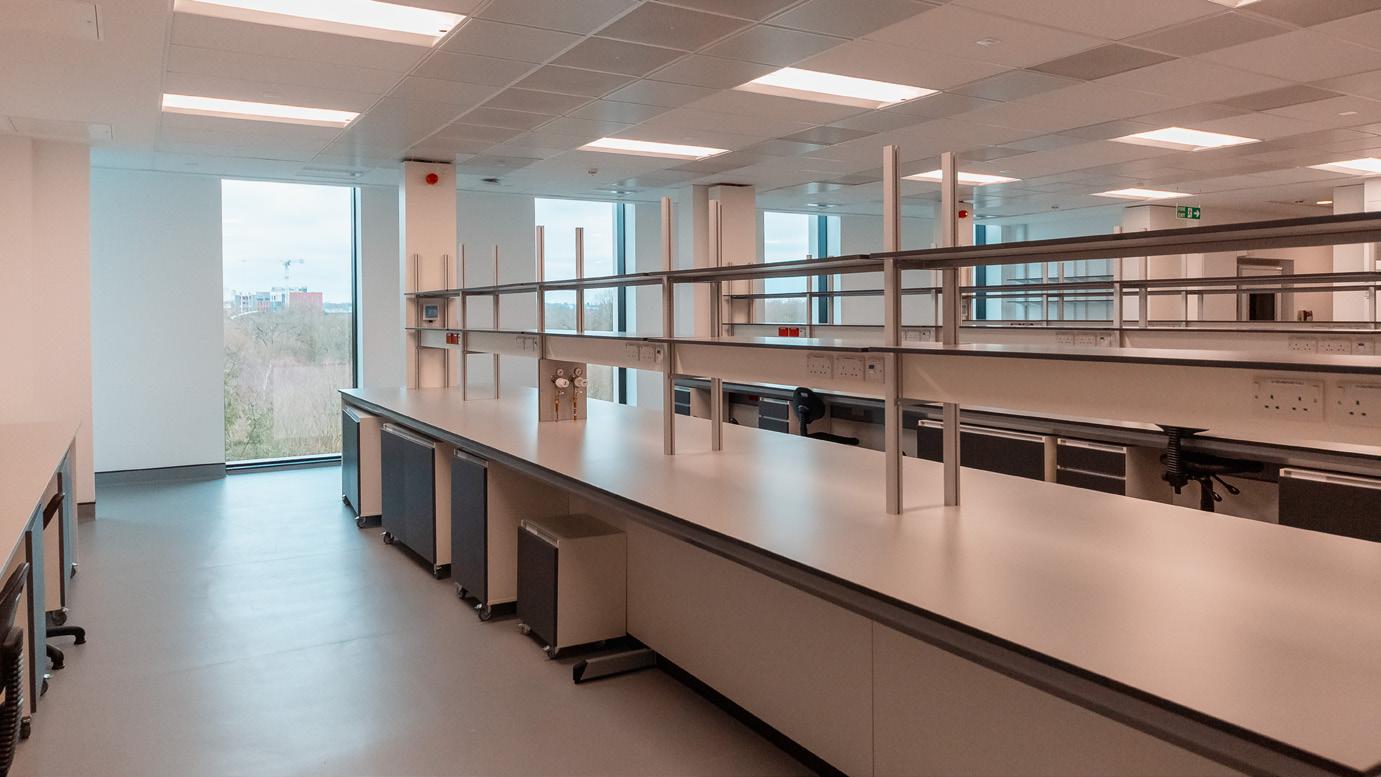
As mentioned previously, science buildings have intensive energy demands by nature of how the building functions. We don’t expect to see the scale of savings opportunities as we did at the Sports and Wellness Hub but, as with all buildings, we do expect to identify some. Surprisingly, most of the areas we identify are where the occupiers of the building are doing, or not doing, something that is causing unnecessary additional energy use.
The savings from the Sports and Wellness Hub serve as a strong reminder that verification, ongoing monitoring and optimisation are crucial to minimising usage beyond what’s necessary – particularly for a sector with such large energy demands.
By taking a collaborative approach to understanding how the building is used, data can be used for the betterment of the end user, the building operator and the planet. ■
For more information on the IBRB, visit: www.willmottdixon.co.uk/ibrb





















































year ago, the government published it’s People & Culture Strategy by setting out plans to ‘Recruit, Reward and Retain’ and drive ‘ Diversity in STEM’. This strategy has been a welcome companion to the UK’s Innovation Strategy, ‘Leading the Future by Creating it’, recognising that success depends on continuing to prioritise people, as we seek to apply science and technology to the problems facing our world, society and economy, and drive innovation for the benefit of all. The strategy demonstrated that our policymakers clearly understand that, whilst investing in facilities and research programmes is paramount for the UK to attain global ‘Science and Innovation Superpower’ status, the whole ecosystem depends on creative ideas, thinking and know-how to be productive and to drive the formation of new
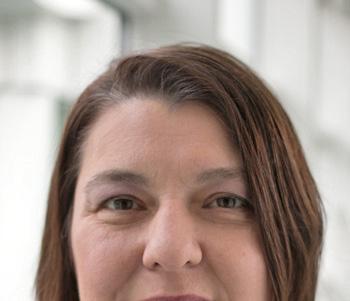


knowledge and solutions - and that all depends on having people with skills honed to the task.
In recent months, a Ministerial Coordination Group and several associated Working Groups have been formed, signalling an appetite from organisations from across the UK’s Research, Development and Innovation (RDI) landscape from industry, academia and within the Innovation, Research & Technology (IRT) sector to work together to identify solutions. Lots of exciting initiatives have been launched in recent months, with organisations working together to promote the goals of the R&D People and Culture Strategy. Some promising developments to watch out for aimed at making sure the UK has enough of the right skills and ensuring people from all backgrounds are inspired into RDI careers, include:
In May, UKRI announced a new partnership with AIRTO to increase prospects for international mobility through a more accessible Global Talent visa (GTV) for international researchers and experts, achieved by increasing the number of eligible host organisations. For the first time, this means that organisations outside the public sector can be approved by UKRI for the GTV, with the first group of organisations to benefit from this development coming from the IRT sector. This change substantially expands and improves the offer and supports many more organisations to make the UK a top working destination for international research and innovation talent.
The success of the UK’s Research, Development and Innovation ecosystem depends on creative thinking and know-how to drive the formation of new knowledge and solutions - and that all depends on people.Jane Gate eXecutiVe director, airto
Whilst the UK has an abundance of expertise and skills, the GTV is a key mechanism for transferring skills across international boundaries, making it possible to bring ambitious scientists, engineers and technology developers to the UK to help drive innovation, for areas of national strategic importance such as transitioning to an affordable net zero energy industry and establish our green economy. Many more IRT sector organisations have now been classified as ‘approved host organisations’, which will enable them to fast-track applications for individuals via the GTV, to expand and accelerate their applied and worldleading RDI activities.
Early in 2022, the Catapult Network took the bold step of publishing its ‘Inclusivity in Innovation Charter’, with all of the Catapult Centres committing to deliver on key actions to promote equality, diversity and inclusion (EDI). By July, a dozen high-profile supporters, including Rolls-Royce and Siemens had pledged their support to the Charter at the
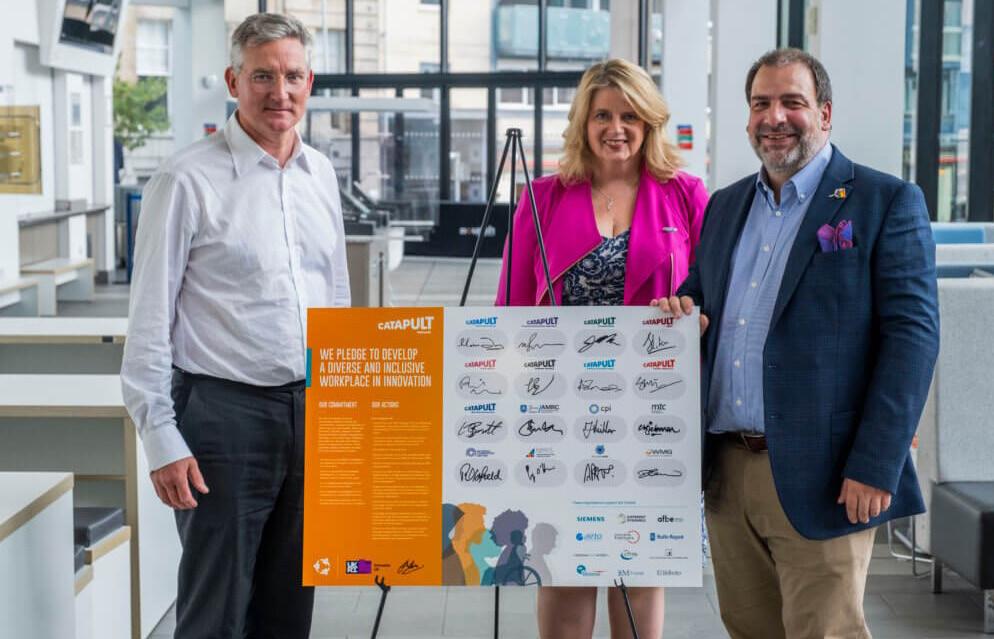
Catapult Networks’ second major event held in Glasgow, recognising the critical role of EDI in innovation and the importance of embedding these principles into their cultures and workplaces. AIRTO was one of these supporters, recognising our responsibility to drive a shared commitment to fair, welcoming and diverse workplaces across the UK’s IRT sector in support of innovation and economic growth.
The ‘Women in Innovation’ programme pioneered by Innovate UK KTN six years ago, is continuing to go from strength to strength, with ever greater numbers of women innovating in business. The 2022/23 programme will open for applications from 22 August 2022 to 19 October 2022 for upto 50 women entrepreneurs to be nurtured to embrace innovation, grow their businesses, and navigate the entrepreneurial ecosystem for positive economic, environmental, and societal change by embarking on a 12-month journey and benefit from a
bespoke business boosting support package. This includes a cash injection of £50K each, tailored business coaching, mentoring and a wide range of networking and training opportunities designed to help grow their innovation further.
Looking forward to the next twelve months for the R&D People and Culture Strategy
Of course, big changes are afoot in government over the coming autumn, and the pressures facing our economythe cost of living crisis, the energy crisis and the impact of the conflict in Ukraine, to name but a few – are immense. These pressures are all the more reason to argue that the government must keep its ‘foot on the accelerator’ for RDI and that means continuing to prioritise the R&D People and Culture Strategy, if the UK is to attain ‘Science and Innovation Superpower’ status and 2.4% of GDP for R&D intensity by 2027. ■
For further information, please visit: www.airto.co.uk
left
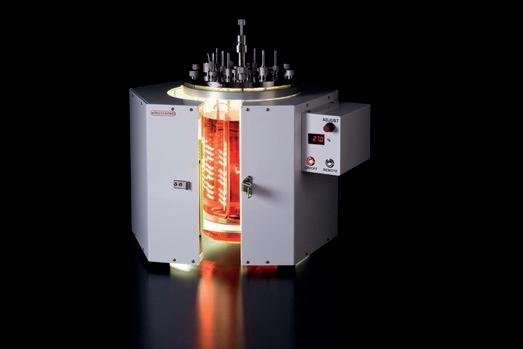



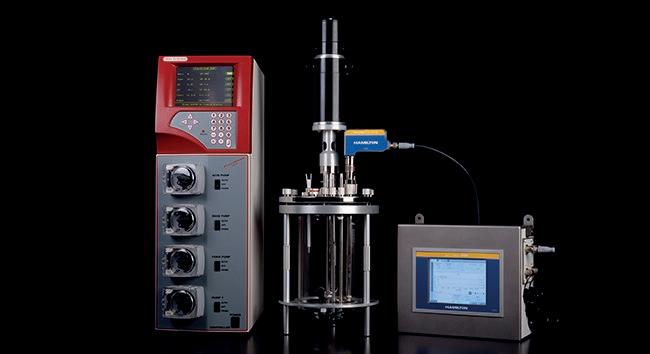
, assesses the prospects for the UK’s life sciences’ sector.
ince the Royal College of Art (RCA) was founded in 1837, its famed alumni have spanned every creative sector from painting and sculpture, to fashion design and film, and from music to sound and stage.
However, to learn that even such a notable institution has acquired a role in creating a new generation of innovative medical devices is still a moment to pause and reflect.
Crocker says the RCA earned its ranking, in the table of university spin-outs in life sciences, via collaborations on design projects which have medical applications.
The UK-based start-up Charco Neurotech, for instance, has designed a non-invasive and wearable CUE1 device which helps people suffering from Parkinson’s to overcome hesitancy and physical inhibitions, by emitting a low-voltage impulse on demand.
Founder and CEO, Lucy Jung, came up with the breakthrough whilst studying for a Masters in Innovation Design Engineering at the RCA and Imperial College London.
It’s one of the numerous intriguing findings from the UK Life Science Start-up Report 2022 authored by Crocker in his Pioneer Group role, helped by research analyst Ross Gray, from JLL - where Crocker was previously head of life sciences, and is now a senior consultant.


Even as the founder of BioCity, and having received an MBE for services to biotech, Crocker concedes that some of the data hoovered up by his former colleague was surprising.
The stand-out finding was that the number of life science start-ups in the UK increased by 24% from the previous period (2014-2018) to 681 between 2016 and 2020.
q uantitative and qualitative analysis of the innovation ecosystem Trends
The data was compiled across a rolling five-year period allowing the identification of trends to be more certain.
“The upward trend was established almost a decade ago, and the latest increase is more than double the rate at that time, which whilst slightly surprising is also very reassuring,” says Crocker.
It’s an impressive rise, and even more so given that the JLL-Pioneer analysis excluded start-ups formed during the pandemic to carry out testing.
Theoretically, they fit the ‘diagnostic’ segment, but are not what most observers of the sector would consider life-science companies, and their existence might well be transient.
Crocker identifies several core reasons for the 24% rise, notably increased investment into the sector which encouraged the formation of start-ups, changes in the spin-out strategies of some universities, the impact of technology transfer teams and the availability of space.
“Whilst there is obviously more to a successful life science sector than simply the number of companies, this growth in start-ups does demonstrate the strength of the industry,” he says.
“At the very least, the creation of more companies means more opportunities to create billion-dollar businesses and develop life-changing technologies.”
The report’s findings about the number of life science start-ups in different regions are equally intriguing, when
Crocker looks behind the expected headline conclusion that the so-called ‘Golden Triangle’ of Cambridge, Oxford and London remains the sector’s dominant force.
“The most established regions outside the South-East (Scotland, the North-West and the East Midlands) have shown a fall in the number of start-ups,” he says.
“However, the emerging areas (the South-West and West Midlands in particular) are showing strong growth, which largely offsets declines elsewhere.
“The common factor between those two regions is a significant rise in university spin-out activity, whereas spin-out numbers have declined in the three regions where overall start-up numbers fell, although we can’t say there is a causal relationship.”
Another section of the report looks at how regional rankings for start-ups have varied over the longer-term, using data stretching back to the 2006-2010 period.
Again, the headline finding (that the South-East is currently in the top slot thanks to Oxford’s contribution) is no surprise, but other trends catch Crocker’s eye.
The steady decline in Wales’ position reflects the growth in the number of new life science businesses in other regions over time, as well as a steady decline in its own numbers,” he says.
“It is now in bottom place, and it’s certainly possible to make a case that the sector should be performing more strongly there than it is.
“Conversely, Northern Ireland has seen steady growth in start-up numbers, in part driven by a resurgence in activity at Queen’s University, Belfast, which has resulted in an emerging life science sector in and around the capital.”

The number of start-ups assessed by city region in the report indicates that Birmingham has increased its contribution more markedly than other cities, indicating that it has the potential to evolve a life science cluster.

The presence of several start-ups on Surrey Research Park has propelled Guildford into the top 20 locations, and Crocker believes it has potential to grow further, not least as the town’s business park is on the market and there are plans to increase the space for life science companies.
“It’s also informative to look at the life science niches most in favour. Almost 40% of the start-ups are in pharma or biotech, reflecting the strength of the UK’s academic research base and its ability to deliver the IP assets which will most likely underpin those fledgling enterprises,” says Crocker.
“However, the make-up of those new ventures varies significantly across the UK. In London, digital health, pharma-tech and med-tech make up almost two-thirds of the newcomers, possibly because of the often-discussed shortage of lab space in the capital.
“In the South-East and East though, pharma and bio-tech dominate, reflecting the availability of both capital and lab space which allows therapeutics’ companies to prosper.
“However, in the West Midlands and North-East, although there’s a decent supply of low-cost space, investment capital isn’t readily available, so the dominant niche is companies in discovery and development services.
“These are focused more on profitability and are able to become cash flow positive with relatively little investment.
“There’s good news for Wales here, as although its overall start-up numbers are falling, the ones that are being formed are predominantly in med-tech, and notably in the Cardiff area where the arrival of Cardiff University’s SPARK should underpin the established expertise of Cardiff Edge Science Park in that niche.”
The research also highlights the widely varied role which academic
institutions play in their local start-up ecosystems.
In the North-East and West Midlands, universities are central to the creation of such emerging enterprises, but in the North-West, East Midlands and London, they are much less important.
Warwick, for example, has become the leading force in its region, accounting for more than 50% of all university spin-outs, not simply start-ups.

Predictably, the research confirms the conclusion of previous reports that companies in London, the South-East and East hoover up more than 80% of all investment into life science start-ups.
However, Crocker counsels that the finding isn’t as pessimistic for other areas of the UK as it might seem.
“Overall, the UK’s life science sector is in robust health, albeit that unless the fast-rising number of start-ups can secure the funding they need to evolve and become successful, then there’s a risk that the expansion will simply create zombie companies,” he says.
“Creating spin-outs is not the only way in which universities can commercialise the value of their IP of course. Some might choose to license the technology, which is likely to generate greater returns for them.
“Equally, a spin-out is generally likely to remain in the area and contribute to the strength of the local eco-system, whereas licensed IP could end up anywhere in the world.
“We also need to see more universities making a significant contribution to developing local clusters. Some are, but many are still under-performing.”
Looking ahead, whilst Crocker isn’t persuaded that the government’s ‘Levelling Up’ agenda will deliver significant funds into life sciences in any region, he remains bullish for the sector’s medium-term prospects.
His belief is underpinned by the most recent Research Excellence Framework analysis (2021), which revealed that almost two-thirds (64%) of the UK’s biological science research power lies outside Oxford, Cambridge, and London.
According to the Department for Business, Energy and Industrial Strategy, 55% of life science companies can be found outside London, the South-East and the East.
Both findings emphasise the importance of relying on data and analysis, rather than just vague and likely out-dated perceptions, when considering the current strength or potential of any sector.
“That’s not to suggest we shouldn’t continue to grow and support the world-class centres of excellence in Oxbridge and London, but there are opportunities elsewhere, for entrepreneurs, start-ups, established companies and investors which should not be ignored,” says Crocker. ■
For more detail about Pioneer Group: https://wearepioneergroup.com/locations
Further information can be found about JLL’s expertise in life sciences at: www.jll.co.uk/en/industries/life-sciences
“ TH e UK’ S l I fe SCI e NC e S e CTOR IS IN RO b UST H e A l TH , A lbe IT THAT UN le SS TH e f AST RISIN g NU mbe R O f START UPS CAN S e CUR e TH e f UNDIN g TH ey N ee D TO ev O lve AND be CO me SUCC e SS f U l, TH e N TH e R e’ S A RISK THAT TH e ex PANSION w I ll SI m P ly CR e AT e z O mb I e CO m PANI e S .”
gle NN CROCK e R , exe CUTI ve DIR e CTORve NTUR e S AND IN ve ST me NT , PION ee R g ROUPBioCity glasgow


with
SOCOTEC’s Advanced Chemistry & Research team has supported our clients’ research and development projects for over 20 years.
Operating within an ISO 17025 accredited laboratory, our research team are part of a wider laboratory group of specialist labs that provide expertise in such areas as environmental, nuclear and more. This level of expertise means SOCOTEC is ideally placed to support your organisation with a broad range of research projects, interests, sectors and specialisms.
SOCOTEC supports a diverse range of

and
requirements by using a vast array of state-of-the-art
including ICP-MS, ICPOES, GC-MS, GC-MS-MS’, LC-MS-MS, HPLC and FTIR.
SOCOTEC offers a bespoke analytical service which

an

suite that effectively meets your
To


the surge in science park development across the UK has been driven by the well-reported economic and social benefits they bring to local communities.
As hubs for research and the development of technologies that make our lives better, the UK’s more than 100 science parks act as a growth engine for the UK as a leader in innovation globally.
Counter-intuitively, however, the science park sector in the UK has been so focussed on growth and new development that sustainability has sometimes been a secondary consideration. While these centres of excellence are driving new modern innovations they are not where many might assume they should be with regards to the environment.
They are not alone in needing to improve of course. In June, the Climate Change Committee released a report highlighting that the UK could fall short of net-zero targets, with a particular worry on action and policy in areas such as buildings and housing. Overall, we’ve seen that across industries, and across the built environment, there have been ambitious commitments made to addressing climate change, but action is slower than it needs to be.
Climate change is the single biggest societal challenge we face, and it would not be unreasonable to expect that such a forward-facing industry should be leading the way in terms of action. Yes, there are reasons that it isn’t, including the sheer pace of growth in the sector. Science parks are also often energy intensive campuses with complex buildings all with disparate uses – from labs and education to industry and data centres. This plus piecemeal development often means that the
resulting power and energy requirements are equally complex and it’s why building a wholly sustainable science park has perhaps felt out of reach.
New approaches to both grid and building infrastructure mean that there are opportunities for the sector to meet the sustainability challenge and match expectations. If science parks are to remain a leading force for change in how we build a better society, being exemplars for other complex campus environments and using technology to improve sustainability is essential, notwithstanding this being an expectation of clients. Nor will technology be the blocker! Attracting funding, co-locating high value businesses and institutions, people, students and researchers is now increasingly reliant on decarbonisation as society shifts towards improving sustainability as well as generating greater social value.
Investment in on-site generation of cleaner renewable energy is one area where science parks have already made
inroads. On-site renewables help achieve better sustainability outcomes while also providing energy resilience –i.e. a way of mitigating against the volatile energy markets we’re seeing in 2022.
Integration of these systems, including legacy systems, is not always easy and understanding how to optimise the use of the energy derived from onsite generation versus energy from the grid is complex. It highlights the need for any building to act as part of an integrated ecosystem and to ensure all systems are integrated and “smart” so that they communicate with one another and proactively contribute to our reduced reliance on fossil fuels and increased energy efficiency. Without this any building will struggle to reap the rewards of on-site generation.
That additional layer of complexity, how each individual building interacts with one another, is also where some of the greatest value can be derived and is where the new ‘grid interactive building’ is emerging as a trend in the sector.

Rob Sinclair, Account Manager at Siemens, outlines how UK science parks should be leading the way in sustainability.
When people think of smart buildings, real-time management and use of Big Data in the control of building services often comes to mind. But the ‘grid interactive building’ takes this further providing similar digital monitoring and controls that allow buildings to better optimise their energy demand and supply by allowing buildings to change their energy loads. For science parks this means that each building – office spaces, labs, data centres – can optimise their use of the grid in the context of the energy use of the buildings next to them.
Meanwhile, at the grid edge, where smart buildings meet smart grids, sensors and technologies that monitor building use can communicate with and inform systems that decide how to draw down power and from which source –on-site renewables or the grid.

It is simple to put into words but complex when it comes to the way the technologies need to interact with one another. Systems need to be able to work together and common barriers to that include procurement managers buying different technologies for different systems that don’t integrate.
Increasingly however, we’re working with businesses that want to overcome these barriers by having centralised, technology-agnostic systems.
We also recently launched our Xcelerator platform – a digital platform designed to ensure that various systems and technologies that underpin a
process, be it in manufacturing or infrastructure, all coordinate with one another. Xcelerator combines technologies from various partners of Siemens, and we aim to help customers make adoption and integration of technology easier using it.
As part of Xcelereator’s launch we have also released Building X, which is an open, AI-enabled suite of technologies that can help design, deliver and maintain net-zero buildings. A common complexity in delivering sustainable smart buildings is the complexity and the number of stakeholders that require different information to help make a net-zero building a possibility. By integrating all these systems into a single platform, science parks can give stakeholders a
single version of the truth and use data to optimise and manage their estates.
It’s these data silos that have previously been a barrier in many areas. But by understanding data in a holistic way we can create better outcomes for energy efficiency, performance, and user experience – including occupier wellbeing.
Delivery of UK science parks as centres of excellence that can drive innovation are crucial in keeping the UK competitive on a global platform. But if they are to remain true centres of excellence they also need to lead the way in sustainability and energy strategy. ■
For further information, please visit: www.siemens.com/global/en
“I N ve ST me NT IN ON SIT e ge N e RATION O f C le AN e R R e N ew A ble e N e R gy IS ON e AR e A w H e R e SCI e NC e PARKS HA ve A l R e AD y m AD e INROADS . O N SIT e R e N ew A ble S H el P ACHI eve be TT e R SUSTAINA b I l IT y OUTCO me S w HI le A l SO PRO v IDIN g e N e R gy R e SI l I e NC e.”
RO b SINC l AIR , ACCOUNT m ANA ge R , SI eme NS

The new IKA multichannel pipettes fit comfortably in any hand and are suitable for even the most demanding applications. PETTE multi is available with either 8 or 12 channels and three different volume ranges, for efficient, accurate and precise dispensing in microtiter or deep well plates.



IKA England LTD.
Pure Offices, Office Suite 1 Fountain House, John Smith Drive, Oxford Business Park, Oxford, Oxon OX4 2JY
Phone: +44 1865 986162, eMail: sales.england@ika.com www.ika.com